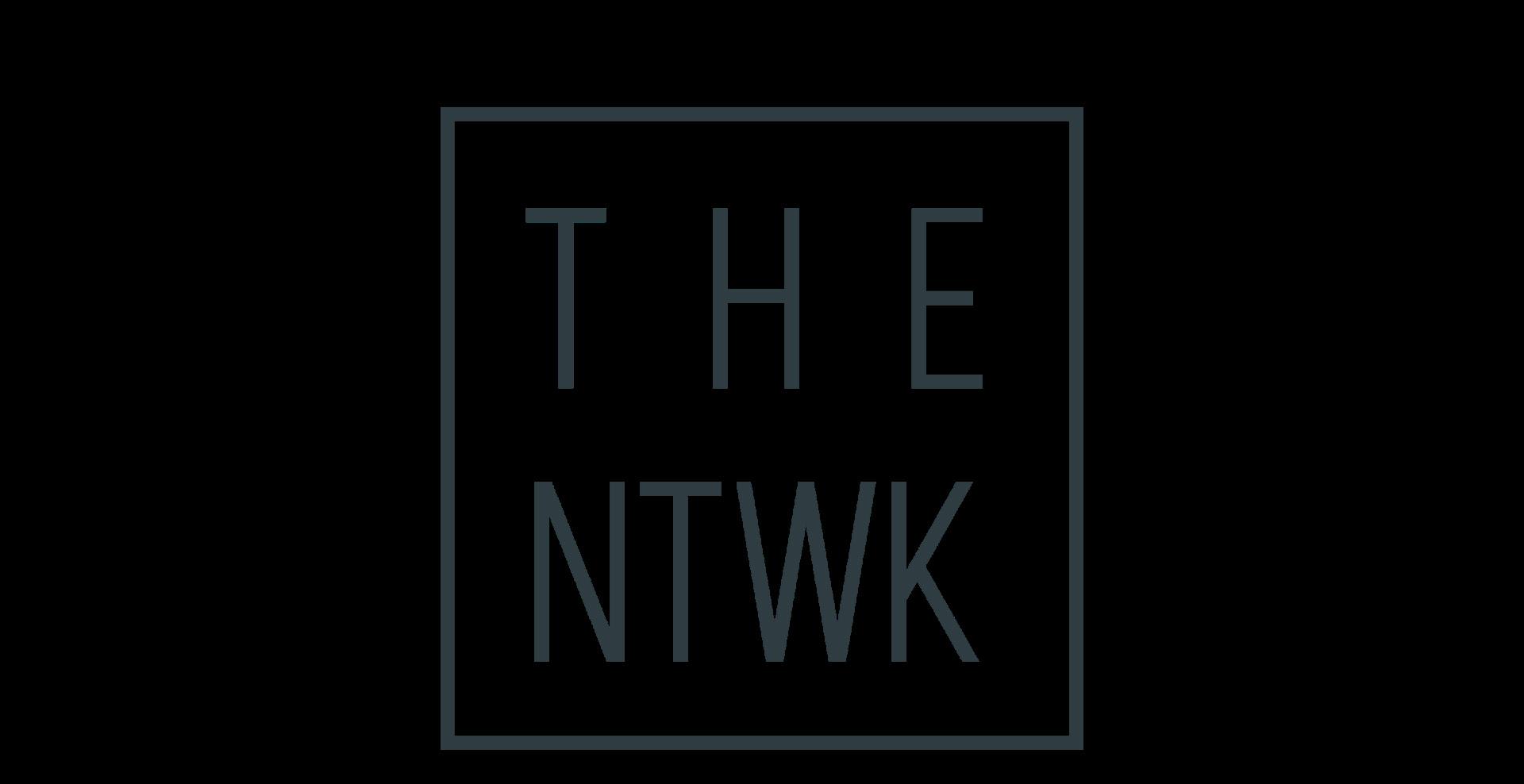




TheNTWK (The Network) is a professional community for digital business enthusiasts. We connect consultants, corporates, entrepreneurs, venture capitalists and academics to create a hub of knowledge around digital business innovation, such as platforms, ecosystems, marketplaces and emerging Web3-enabled businesses.
Our community exists to facilitate learning and business growth through collaboration, co-creation and interaction in a friendly and supportive professional environment. We do this through knowledge, interaction and fun!
Our goal is to harness the strength of our community to co-create content, services and events that make TheNTWK the one-stopshop for all things related to digital business innovation and strategy. For this reason, all voices are welcome to contribute!

Following the success of last year’s TheNTWKSummit Report, we decided to produce an interim report highlighting the most important digital trends that affect our members and the wider community working in the digital economy. This report represents a glide slope toward this year’s TheNTWKSummit taking place in Barcelona, May 18-19, 2023
The EU Digital Trends Report highlights some of the key themes that we will explore in more detail at the Summit. The content is based on a survey of digital innovators, 1-to-1 interviews, and extensive research and analysis of current digital trends, focusing on four key sectors: Financial Services, E-commerce, Energy & Mobility, and Health. The articles were written, peer-reviewed and edited by the NTWK team and a crosssection of contributors representing TheNTWK community. Our objective with this report is to highlight a set of digital innovation trends that will impact European digital businesses in 2023.
Questions? Feedback? Want to partner with TheNTWK on the next report?
Contact us via contact@the-ntwk.com
Digital Ecosystems will make it into mainstream strategy discussions. Platform-based Business Models will continue to grow faster than traditional pipeline businesses. Web3 will still be figuring out a viable value proposition. Metaverse will be one of the emerging places to do business. Brand Experience will be increasingly phygital and omnichannel. Sustainability will increasingly drive business strategy.
Due to this era of digital transformation, companies have shifted priorities to reinvent their businesses. There is an urgent need to adapt and accelerate the adoption of emerging technologies. Staying on top of the latest trends in digital innovation is no longer optional. It’s difficult to determine which changes will stick and which will fade away, but it seems that certain trends will significantly influence our digital future.
Europe has a unique environment for digital platforms and ecosystems, bringing great opportunities to succeed as well as distinct challenges to overcome in launching and scaling digital platforms and ecosystem businesses.
Opportunities to succeed and grow Europe’s share of the global digital economy are obvious in light of the relatively small market capitalization of European-based platforms compared with America and the Asia-Pacific region. Nevertheless, the European market is large and can access a vast, highly-skilled and multinational talent pool. Exciting developments around Web3, digital assets, metaverse, digital/ phygital experiences, and sustainability create opportunities to develop new platforms and business models, or strengthen and expand existing ones, while generating lasting value for consumers, businesses, societies and the environment. European platforms can also benefit from embracing the new regulatory environment and while preparing for similar regulations globally.
At the same time, European platforms face distinct challenges to overcome compared to other regions. American and Asian platforms
already have a strong presence in Europe and bring with them significant funding and lobbying power. The European investment environment is much more conservative in comparison, tempering the ability of start-ups and scale-ups to move as quickly as they would like. Furthermore, the changes required by new regulations will take time and effort to implement, with outcomes that are still uncertain. Before new technological developments can become valuable business propositions and move into the mainstream in Europe they will also have challenges to overcome. These include, but are not limited to, ease of adoption, perception of trust, proven use cases with tangible value and improved technological backbone. Despite these and other uncertainties, which are unfolding in real time, we believe that the following year will bring substantial progress towards a more advanced digital business environment in Europe.
What Europe needs is a mindset shift across start-ups, incumbents, investors and governments. We need to work even more together across European borders, leverage ecosystems, increase investments, enable long-term view and truly focus on the value created for all parties.
With these overarching themes in mind, we have structured our report into seven chapters. First, we provide you with context for the key EU digital trends and sections laying out the basics of Web3, Metaverse and NFTs. The last chapters focus on highlighting the importance of intentional Brand Experiences, strategic partnerships through Ecosystems, and Sustainability as an ethos as well as a business strategy.
• Europe continues to lag behind compared to other regions. If we focus on the Top 100 Platforms by market capitalization, Europe only has 2%.
• Digital transformation can be achieved in two ways: process and/or business model.
• Of the companies lobbying the EU on digital policy, 20% are US-based. Less than 1% have head offices in China or Hong Kong.
• Legislation is always a source of uncertainty; not necessarily negative or positive.
• A European startup receives around $300K and a US one receives $8M; Europe is on average more conservative.
• If we invest, we grow. Since 2004, Europe has created over 200 unicorns, most of them VC-baked.
The situation in Europe regarding digital innovation and transformation has been accelerated in the past years. Due to Covid-19, companies had to go digital and had to do it fast. Nevertheless, Europe continues to lag behind compared to other regions.
If we focus on the Top 100 Platforms by market capitalization, Europe only has 2%. For this reason, we need to address the situation with the 16x Challenge. Peter C. Evans has given us five strategies Europe can adopt to overcome this challenge and grow more native platform businesses:
• Accelerate platform startup growth.
• Expand incumbent platforms.
• Seize Web3 opportunities.
• Build pan-European super-apps & digital wallets.
• Invest in European platform talent & leadership.
First of all, we need to distinguish between process digitalization and digital business models. When you look at some specific industries, their current business model remains the same, but they have implemented a lot of digitalization to improve and automate processes that make them more efficient. Digital transformation can be achieved in two ways: process and/or business model. Some sectors are more advanced than others, starting with process efficiency and digital transformation, and ending with digital business model as platforms.
Peter C. Evans Chief Strategy Officer McFadyen Digital

To overcome the 16x Challenge: accelerate platform startup growth, expand incumbent platforms, seize Web3 opportunities, build panEuropean super-apps & digital wallets and invest in European platform talent & leadership.“
One key fact is how technology is evolving, and how we are able to absorb the capabilities that this technology is allowing us to do. One thing is to understand and manage technology, but making changes in the management process, which is always slow to take effect. So, it’s not an issue of technology; the technology and the infrastructure are there. It falls to a complete mindset shift, where the big block is to move in towards digital ecosystems and leveraging ecosystems for innovation.
Geoffrey Parker Professor Dartmouth College“It’s a matter of learning how to get what you want from the technologies instead of what you dream. There’s been a lot of fantasy in terms of what people thought technology was going to do for them.”
 Natalia Olson Urtecho Director of Government Partnerships Plug and Play Tech Center
Natalia Olson Urtecho Director of Government Partnerships Plug and Play Tech Center

Matthias Walter and Natalia Olson Urtecho gave us these approaches when asking about how regulation and legislation impact digital innovation in Europe. If you are a pioneer in that change (for instance, in energy) you may be stripped out because of legislation.
Now, the question is how and who is lobbying for these regulations. The actors lobbying the EU’s digital economy range from Silicon Valley giants to Shenzhen’s contenders; from firms created online to those making the infrastructure that keeps the internet running; tech giants and newcomers. A report from the Corporate Europe Observatory & Lobbycontrol published in 2021 says that out of all the companies lobbying the EU on digital policy, 20% are US-based, though this number is likely even
higher. Less than 1% have head offices in China or Hong Kong. This implies Chinese firms have so far not invested in EU lobbying quite as heavily as their US counterparts.
Legislation is always a source of uncertainty; not necessarily negative or positive. It depends on how it comes. However, it is definitely a source of uncertainty that needs to be followed very closely. We could also say that legislation brings greater clarity and consistency around the world. The lack of regulation is one of the reasons why we’ve seen some of the most spectacular falls in 2022. If regulators get into more of an active market-shaping role, we could see where the market is going and its size. Looking at banking, as an example, the introduction of open banking regulations has enabled FinTech and a whole range of new players to be involved, rather than just the high-level banks in each country.
“Overregulation sometimes it’s going to be a problem with digital transformation because, as you’re trying to move and digitize a lot of your processes, a lot of these policies will get in the way.”
“Regulation has always been a huge driver for innovation, because it can unlock opportunities, but it can also force companies to think beyond their current boundaries.”Fig 2 - Source: Corporate Europe Observatory & Lobbycontrol based on EU Transparency Register | August 2021
When it comes to scaling up, we have to really change the way the ecosystems are designed. “Can we create certain tax incentives? Can we create certain tax abatements? Can we create some incentives for more investors? Why is the US larger? That’s because we invest a lot.” says Natalia Olson Urtecho, Director of Government Partnerships Plug and Play Tech Center.
In Europe, we have more universities and accelerators than the US but 70% fewer unicorns. Why is that? As the following figure shows, a European startup receives around $300k and a US one receives $8 million. Europe has been notoriously bad at providing the right level of investment and venture capital money into its traditional market. According to Mª Julia Prats, Professor and Executive Board Member at IESE Business School, “European firms are on average more conservative”.
We’re now in this kind of “dark winter” bear market recession and the valuations that we see this year are much smaller than they were at this time last year. Companies that wanted to raise X, now have to raise half of X. As stated by Cecilia Mosze Tham, co-founder and director of Futurity Systems, “we are now in a phase where we’re weeding out the weak players, and that the money will be much more critically placed in projects. You can’t fake it till you make it anymore”. Funds still have the capital to deploy and the interest to do it, as long as you come up with an interesting idea or application that solves a real problem.
Daniel Trabucchi Senior Assistant Professor Politecnico
“The most urgent mission we have as scholars, and also TheNTWK as a community, is to create a sort of platform culture to help companies embrace these opportunities.“
If we invest, we grow. Since 2004, Europe has created over 200 unicorns, most of them VC-baked.
• Web1 - read only; Web2 read-write; Web3 - read-writeown
• Centralized platforms are being displaced.
• Blockchain-based social networks, transactions and businesses grow and thrive.
• Security
• Transparency
• Traceability
• Efficiency & Speed
• Automation
• Decentralized Autonomous Organizations (DAOs); transition from a corporate top-down pyramid to a user-focused decentralized form.
• Decentralized Finance (DeFi), hosted on blockchain networks and deployed by smart contracts.
• The adoption has not been as widespread as some predicted it would be.
• Lack of trust among blockchain users is also a concern.
• Is the current web3 really decentralized? Large technology companies may seek to develop a dominant position.
• DeFi Transactions & Tax Implications
• The opinion of developers about web3
From retail and e-commerce, to media and entertainment, to healthcare and energy, almost every sector will adopt Web3 blockchain technology in their business and will completely transform existing conventional processes.
Starting from the fact that huge corporations, like Google and Facebook, set most of the rules about what we can and can’t do online today, the main objective behind Web3 is to give us the tools we need to create an online space that we truly own, and even implement a digital democracy.
In summary:
• Web1 (read only): Consisted of a few people creating web pages and content for a large group of readers, e.g. static info publications, subscriptions, and linking via URLs.
• Web2 (read and write): Considered the primary form of web interaction for most of today’s users, focused on participating and contributing. Social exchanges among users on social media platforms.
• Web3 (read, write and own): Decentralized data transactions between digital wallets on blockchains. Web3 is built on a foundation of decentralization, openness, and user utility.
Let’s travel back in time to when Amazon just started. If I want to buy books from you and I don’t know you, I am not going to send you money. What Amazon did was establish a sense of a trusted source and that’s how the platform economy started, with the necessity of a centralized form of trust. This is the main reason why we now have big tech becoming so big, because of the centralization of our trust and data. Thanks to blockchain, we can place trust in ourselves and in the algorithm that is supposedly helping us to kind of maintain that data, privacy and trust; then it comes again the Web3 decentralization.
When it comes to social media, anyone knows how easily their account can be removed and how their content can’t always be controlled, recovered or monetized
An early solution to this problem can be achieved, for example, with Lens Protocol. “With Lens Protocol, you are in control. You own your profile, where you use it, how you use it, and even how you monetize it. That means you have the power over your content, and it’s all right there, as an NFT, in your wallet. It’s not just easy. It’s how digital identity should be: yours ”
Erich Joachimsthaler Founder & CEO of Vivaldi Group“The power of platform businesses is in demand-side effects, that’s why we need interaction fields. And if the vision of Web3 will be a reality one day, consumers will become enormous sources of value creation.“

Usually associated with cryptocurrency transactions, blockchain has a wealth of potential for many business activities, particularly in building trust. Benefits for companies that are implementing blockchain technology:
• Security
• Transparency
• Traceability
• Efficiency & Speed
• Automation
By creating an immutable end-to-end encrypted record, blockchain helps prevent fraud and unauthorized activity by creating a path every step of the way. As it’s distributed, transactions and data are recorded identically in multiple places: all participants can access the same information at the same time, providing full transparency. We can also talk about optimizing traditional paper and time-consuming processes by using blockchain to simplify these processes, and transactions can be completed faster and more efficiently. Transactions can even be automated using “smart contracts,” minimizing human intervention and reliance on third parties to verify that contract terms are met.
The Web3 possibilities are plentiful. Using a digital wallet to access financial services and blockchain games that allow remote online income are some of the biggest use cases of Web3. From DeFi, to blockchain-based gaming, to decentralized company structures or organizations, to new social platforms where creators own their data.
If we talk about Decentralized Autonomous Organizations (DAOs), it allows us to make the transition from a corporate topdown pyramid to a user-focused decentralized form. DAOs can also be used as crowdsourcing tools to create web3 platforms. In a nutshell, DAOs are extremely flexible and trustless governance/funding mechanisms.
As a DAO example, we have Braintrust. They categorize themselves as the first decentralized talent network that connects highly skilled technical freelancers with the world’s most reputable brands. It’s built on the blockchain as a differentiator, and the main purpose is to transparently distribute control of its network to the community members who contribute to building it. Not only does this put more control in the hands of the community, but it also helps grow the network rapidly.
Fig 8 - Source: “Token Economy” Book by Shermin Voshmgir | 2019On the other hand, we have Decentralized finance (DeFi), which is perhaps known as “the” Web3 foundation, hosted on blockchain networks and deployed by smart contracts. DeFi’s decentralized applications (DApps) cover the entire range of traditional finance, but without banks or market makers. All of this can not only help tackle bureaucracy issues but also speed up transactions and enable a financial system that can be more transparent and accessible.
Using DeFi, you access your funds or assets using a secure digital wallet. When you want to transact, you can initiate transactions through smart contracts, which means you and the other party agree to a number of specific conditions (as simple as “if this … then …” statements written in code). For instance, a smart contract can be created to send funds to a particular account on a regular basis, and this will continue if enough funds are available.
One example of DeFi is Aave, a decentralized lending protocol that lets users lend or borrow cryptocurrency without going to a centralized intermediary. Users deposit digital assets into “liquidity
pools,” which become funds that the protocol can lend out. Launched in 2017, Aave is the most popular DeFi lending platform in the market.
Several countries around the world have already laid down certain guidelines for the taxation of DeFi transactions. Some are in the process of laying down the procedures. In the U.S. and many other countries, cryptocurrencies are treated as property for tax purposes. That means if you’re interacting with DeFi protocols, you may incur capital gains and income tax liability. When talking about capital gains refers to when you sell, exchange, or otherwise dispose of your cryptocurrency, you incur capital gains or capital losses depending on how the price of your crypto has changed since you originally received it. Ordinary income refers to when you earn cryptocurrency through any means whether that is mining, staking, or various forms of interest, you recognize income based on the
fair market value of the cryptocurrency at the time it is received.
The next example shows an interaction with a DeFi protocol where the user recognizes capital gains, capital losses, and ordinary income.
Certain DeFi transactions are discussed below:
• Lending transactions
1. Loan Collateral: the economic ownership of the collateral will remain with the borrower. Hence, the deposit of some tokens as collateral should not generate a taxable event. Accordingly, there should not be any tax implications.
2. Forced Liquidation: Because of the volatility in the crypto market, sometimes the value of the collateral decreases and the loan-to-value ratio cannot be maintained. In such cases, the platform issues margin
calls (e.g. MakerDAO requires collateral a minimum of 50% of the value of the loan). The taxation regime could vary depending on the tax law of the country.
3. Receipt of collateral back in a different cryptocurrency: the difference in value may be taxable as capital gain taxes depending on the local tax law of the country.
4. Self-paying loan: some protocols offer this option, where the borrower deposits the collateral, borrows the capital and the loan is repaid over time by the yield protocol earns from the collateral (e.g. Alchemix Protocol). The taxation regime may vary depending on the local law of the country.
1. Issuance of additional tokens: the platform may distribute interest/rewards by deposit of additional coins in the lender’s wallet. The taxation mechanics may vary per the laws of the country. In most cases, this should be treated as an ordinary income. E.g AAVE aTokens.
2. Increase in the value of existing tokens: sometimes lenders are rewarded as an increase in the value of interest-bearing tokens of the lender. The taxation mechanics may vary per the laws of the country. Since only the value of existing tokers has increased, this could be taxed as capital gains. E.g. cTokens.
1. Receiving governance tokens: many DeFi platforms distribute tokens as incentives for activities. These holders can vote for issues that need a decision. In
most cases, these should be taxed as ordinary income.
2. Trading governance tokens: if the value has increased from the time of receipt, it could generate capital gain tax.
• Others
1. Wrapped tokens: a token whose value is pegged to another coin/token. Some protocols may have some specific requirements to wrap tokens before they can be deposited. The tax implications, in this case, can be debatable. One may argue that this wrapped version has distinctive features; others may say that is a mere representation of the original token and it doesn’t generate any taxable event.
2. Liquidity Pool Transfers: the value of these tokens increases based on pool demands and trading fees. The liquidity provided is converted back to the original currency at the time of withdrawal. This may hence generate taxable
events. Separately, there may be tax implications at the time of deposit too, on the argument that is crypto-tocrypto trading.
3. DeFi Rebrasing Tokens: in this case, protocol periodically adjusts the total coin supply based on the token’s price fluctuations. There could be two approaches to taxes here; capital gains tax when these tokens are sold at a value higher than the value existing at the time of deposit; or treating the rebracing income received every time as dividend income or ordinary income.
In all:
• Exchange of one token with another in most cases would be taxable (where applicable) under the head capital gains.
• Crypto currency earned directly in most cases would be taxable (where applicable) as ordinary income.
Nupur Jalan Chartered Accountant, Adv. LL.M. (International Tax Law) Tax Consultant
“The determination of tax implications in case of DeFi transactions should be based on facts, circumstances and actual nature of the transactions. The taxation mechanics for the same DeFi transaction could vary across countries based on the local tax laws of the countries.“
Source: nupurjalan.com “Decentralised finance (DeFi) transactions- Certain tax implications” | 2022
We have already talked about the benefits and possibilities of Web3. But, why the adoption has not been as widespread as some predicted it would be? The biggest hurdle to adoption is still the relative newness of blockchain and the shortage of skills needed to develop and use it. It requires broad adoption to work effectively, and an entire system overhaul. If neither the accessibility nor trust and knowledge around the technology isn’t yet there, it will be difficult for businesses to successfully embrace it.
 Breadcrumb.vc & Applied Network Effects
Breadcrumb.vc & Applied Network Effects
“Showing the chart of people who have bought crypto, is not adoption. We weren’t talking about people who bought domains to show the adoption of the internet. It was actually people using the internet, going to the internet and creating on the internet.”
Cecilia Mozse Founder & Director Futurity Systems
Founder & Director Futurity Systems
“I will be my own custodial. My data won’t be stored in some centralized cloud, it will be in edge computing that is authenticated by me via blockchain. That is in theory. But, as we know, in practice it doesn’t.”
On the other hand, the lack of trust among blockchain users is also a concern. There have been highprofile hacks of some of the most reputable blockchains. For example, Solana; a hack that caused up to $8 million in funds to be lost from a number of Solana-based e-wallets. In the latter case, such as Bitcoin, users who lack technical expertise must simply trust that the software works. It’s in this area that regulation will have to fill the gap left by a blind trust.
Another key question: Is the current web3 really decentralized? We could put the example of OpenSea, the world’s first and largest web3 marketplace for NFTs and crypto collectibles, one of the most important DApps (Decentralized Applications). Nevertheless, when trying to access OpenSea from a country banned by the US, you can’t successfully enjoy its services. The access depends on third-party infrastructures created in order to filter who can and who cannot access. It is clear at this point that the current Web3 is not fully decentralized and, although there is much progress in achieving it, we still have a long way to go to achieve true decentralization in Web3.
Peter C. Evans Chief Strategy Officer McFadyen Digital“Large technology companies may seek to develop a dominant position. In other words, Web3 may not look much different than Web2. They have strong economic incentives to create their own platforms. In that case, we may see network tribalism emerge.”

What do developers think? And their interest? Where do developers use blockchain?
From the developer’s point of view, most are building experience with blockchain in their free time or haven’t touched it at all. Regardless of hype cycles and trends, the popularity of blockchain and Web3 is undeniable, and we’re seeing people learn and collaborate with blockchain at an astronomical rate.
Simon Torrance Founder Embedded Finance & Super App Strategies“I don’t think we’re going to see huge disruption from digital currencies in the short term. And, of course, the regulation is not strong here yet. There’s so much to do just with existing financial service capabilities and making it very easy for developers, the kingmakers in a digital world. Everything is connected, and therefore everything has a software layer on it.“

• Portability and interoperability of identity, data, and digital assets; (VR) and Augmented Reality (AR); and digital ownership.
• Metaverse is a fresh chance to train a more profound and creative relationship with customers.
• Three ways of looking at the metaverse: consumer, enterprise and industrial.
• Integration of online and offline channels.
metaverse
• Hardware
• Identity
• Addiction and Mental Health
• Privacy & Data Security
• Currency and Digital Payments
• Metaverse anxiety: people don’t want the metaverse as an escape from reality.
• Two separate worlds: consuming for sustenance vs consuming for pleasure.
• For companies to find value in the metaverse, there isn’t one single point of entry.
• Ethical Metaverse Principles

“What is the Metaverse? If you asked this question to four people, you usually get four answers. I think the common thread is that the metaverse is not yet here, it’s more of a vision. The core of the metaverse is social engagement: you can work, love, and play in the metaverse. In a near future, we’ll be able to travel from one metaverse to another. In conclusion, the virtual world is not replacing the real one; is complementing it.“
Today, people tend to socialize through social networks, using augmented reality filters that totally change the appearance of the person, becoming avatars, purchasing virtual products, and watching famous singers in online game environment concerts. Beyond the hype and critique, these behaviors and uses are invoking Web3 and the metaverse.
The Value Creation in the Metaverse Report from McKinsey found that the Metaverse could be worth $5 trillion by 2030. On the current pessimism about the conventional crypto market, the report highlights that in the first five months of this year, more than $120 billion has already been invested into metaverse-related technology and infrastructure.
Portability and interoperability of identity, data, and digital assets are some of the common premises of the metaverse. In this wider ecosystem of applications and products, Virtual Reality (VR) and Augmented Reality (AR) play a part, but so does digital ownership. If I buy a digital item for my avatar from one service, like a necklace, I could go to a second service and my digital necklace would be recognized as mine and rendered effectively.
So, what is driving the metaverse right now? The only thing clear is that metaverse is more of a kind of concept and is literally being built right now. We know exactly the value of physical things, demand and supply, and we wouldn’t invent the value of 500 kilograms of gold. In the metaverse world, everything is digital and easily copyable. The value isn’t driven by supply and demand, because supplydemand is artificial interaction in this case. The value of the metaverse right now is a sentiment; the feelings and emotions of our digital experiences
Many giant firms around the world are looking at the metaverse as a fresh chance to train a more profound and creative relationship with their customers and generate new income sources. A number of organizations have figured out how to be part of it, but some are doing innovative things.
• Gucci had a massive 19 million people flock to the Gucci Garden within the Roblox environment.
• Nike established its own ‘Nikeland‘ wherein participants could play games, socialize, and dress up their avatars with digital items like the Air Jordan and Nike Blazers.
• Acura was the pioneer when it came to assembling a virtual car showroom through Decentraland.
• Dolce & Gabbana released a collection of nine NFTs which were made available alongside real-world couture.
• Estee Lauder made a big impact at Decentraland’s MetaVerse Fashion Week, where they presented avatars with NFTs that enabled them to possess a “magical glow” akin to the brand’s popular night creams.
Specific sectors that are really pushing on the metaverse are obviously industries that are based on emotions, which are gaming and eSports. A really good example is a football fan and, as a fan, needs to find that new experience and the sentiment of belonging to a community. This fan also needs recognition, so buy football merchandise. In summary, people identify in this trifecta of emotion, identity and experience, and these are the main driving forces behind the metaverse economy right now.
There are three ways of looking at the metaverse: consumer use, enterprise use and industrial use. It is especially interesting to mention some real and tangible examples of what can be achieved in these areas with the metaverse.
A Spanish design agency called Masquespacio has created the interior of the first Mango Teen shop in Barcelona, which is informed by the metaverse and aims
to provide an interactive and dream-like shopping experience. This new shop experience was developed following a previous study of the 11-13 year old customer target. Retailers have a great opportunity for the creation of environments where their customers are going to be able to potentially try on virtual clothes and create their own avatars. The adoption rate in this case is going to be higher because it’s closer to what we’re doing currently.
Entertainment is a prominent sector where the metaverse is being eagerly adopted. A new video of Paul McCartney was launched last year by Hyperreal, using the technology to de-age and render him performing in creative environments. The same company recently launched a project where The Notorious B.I.G, one of the most famous rappers of the 90s, is brought back to life as the protagonist of a Hypermodel Metaverse
Digital humans could also have applications in education or medicine. Doctors are starting to use VR & AR for telemedicine helping cancer patients get away from their illness for a few moments. In education, famous scientists could also be brought back to life to explain certain principles. Imagine that Einstein could explain to you what the theory of relativity is, or Newton can show you physics. It allows offering this kind of content to a whole new audience
Santiago Sanchez CEO TheEtaliers“In the retail sector, we are seeing an integration of online and offline channels, much more experiential and digitized stores. More square meters per store and fewer stores to offer unique buyer experiences.”

In a digital environment, problems can be found, analyzed, and fixed quickly – or better yet, discovered before they arise. A whole level of collaboration can arise and traditional processes can be substituted by connecting technologies and teams from different disciplines and regions. It’s a great opportunity for everyone to try out new ideas easily and quickly.
Siemens’ Digital Native Factory in Nanjing is one example. According to the Siemens website, the entire factory was simulated with a digital twin, which optimized the building, and detected and mitigated potential problems at an early stage. The true benefit of this digital plant: manufacturing capacity increased by 200%, and productivity by 20%. Off-site maintenance is going to be a massive market that will explode.

“The B2C [metaverse] will move quicker than the B2B, and I think there are clear jobs that B2B will do and deliver pretty fast and pretty well. On the other hand, everybody will get utterly confused by which app to actually go on. Which is going to be offering me the best experience? It must have standards behind it and be recognized by people recommending it.”
• Hardware. Right now, the metaverse highly depends on VR (Virtual Reality), AR (Augmented Reality), and MR (Mixed Reality) technologies and devices. Since most of these are not lightweight, portable, or affordable, metaverse cannot have wide-scale adoption. Apart from hardware accessibility, the challenge lies in having high-quality and high-performance models that can achieve the right retina display and pixel density for a realistic virtual immersion.
• Identity. Have you ever wondered if your social media friend is as interesting as online in real life too? The same thing might happen with metaverse as you will be accessing it through your avatars. Another problem lies in proving your identity as bots can easily mimic your style, data, personality, and whole identity. You will need different verification methods like facial scans, retina scans, and voice recognition for authentication.
• Addiction and Mental Health. If you have watched Ready Player One, you know exactly how metaverse can affect your mental health. Addiction to the virtual world might not only lead to mental health problems like depression, and anxiety but cause obesity and heart problems due to the sedentary lifestyle.
• Privacy & Data Security. We often hear about some MNCs having a data breach. Metaverse will be storing more than your email addresses and passwords. It will store your behaviors too. With a huge data mine, the technology needs to ensure information privacy and personal data security for every user. This will require new security strategies.
• Currency and Digital Payments. Metaverse will not be limited to gaming. It will be another online marketplace connecting billions of users around the world. With so many currencies and different cryptocurrencies, there will be a need for quick and effortless exchanges. Not to mention secure transactions.
Source: https://www.analyticsinsight.net/challenges-in-metaverse-and-how-toovercome-them/
 Geoffrey Parker Professor Dartmouth College
Geoffrey Parker Professor Dartmouth College
“The metaverse it’s a technology looking for an application, as opposed to a solution to a problem. Until we figure out problems for which that’s a good solution, it will stay niche.”
Ethical Metaverse Principles by The Responsible Metaverse Alliance. Read more here

“A sort of new meaning enabled by the metaverse is still missing. We don’t have yet that vision of what it can bring, and this is absolutely normal, we’re dealing with innovation. We need time to embrace the opportunities that this technology can bring.“
A recent National Research Group survey on the public’s perception regarding the metaverse offers insights into what consumers want, don’t want or might struggle to understand in this new world. Some of the main takeaways are:
• 2 out of 3 consumers are excited about the possibility of entering virtual worlds as if they were there in person.
• 56% think the metaverse will be better than existing social media platforms because it will be more similar to physical interactions.
• 78% said they miss the physical element when interacting virtually with others.
• 79% believe that when people can interact physically, they treat each other with greater kindness.
Metaverse anxiety comprises factors such as the current levels of social media addiction. This has made it harder to disconnect from tech and be present in the real world. In order to address these concerns, technology companies will need to build metaverse platforms that are intended to augment and extend real-world relationships, rather than make them obsolete
It is clear that most people don’t want the metaverse as an escape from reality, but as a tool that allows them to interact in a more empathic and intimate way. These expectations can’t be ignored by those who are building this “new reality.” In other words, the focus of the metaverse must be on the human experience, and its purpose should be to strengthen social bonds. Numerous technological and creative challenges lie ahead as we build this vast multidimensional virtual universe.
It may be, from our very privileged and developed society’s point of view, that we could use the metaverse as two separate worlds with two different purposes: consuming for sustenance versus consuming for pleasure. We can replace many of these things that we
consume for pleasure with digital assets and thereby use up fewer natural resources.
Regarding companies’ attention to this topic, do they need to take a good look at the metaverse and decide whether to get involved? Yes, absolutely! Do they have to get involved in the metaverse now, or risk being too late? No! Companies can sit back and watch as the metaverse develops. For companies to find value in the metaverse, there isn’t one single point of entry. Nike already has a fan base where they can build the community. Facebook has a different strategy, they went straight ahead with the hardware. In general, they need to find what they can do best and look for that as an advantage and where they best fit.
Whatever the metaverse ends up being, a key idea will be that you can actually demonstrate rights of ownership and resale. The metaverse is still in the early stages. As soon as we have hardware that makes it easy for us to use it, affordable for us to buy it and meaningful for us to be there; then we’ll see you in the metaverse!
Sergi Sagàs Chief Innovation Officer Hyperreal“People need to get educated and understand what the limits are. Critical thinking is crucial in using the tools we have; to equip ourselves with knowledge and understand progress and innovation from different angles.

• NFTs have enabled us to reimagine the possibilities for a wide variety of industries.
• Europe has only 20% of the Top 100 Worldwide NFT Platform Companies.
• Difference between dynamic and static NFTs.
• NFTs are now popping up across an array of industries and use cases.
• A massive 77% drop was observed in terms of USD traded between Q2 and Q3 2022.
• Investments in NFTs are speculative and illiquid without a lot of historical data to study.
• Dynamic NFTs allow new ways of engagement and driving traffic.
• Taxation of Virtual Assets. Key Concepts
• NFTs do not receive the trust that would be required to really develop the overall NFT business.
• NFTs need to be so embedded in what people do in an automatic way before it really gets into scale.
• The speculation will be a tough topic to overcome.
NFTs are digital cryptographic assets with unique metadata assigned to the user’s ownership. These assets hold the exclusive properties to stay tamper-free, divided, or faked at any cost. Within a short period of time, NFTs have grown in utility and exploded in value. NFTs have exploded in popularity in the past two years. They’ve enabled us to reimagine vast possibilities for various industries such as art, real estate, fashion, and more. Their influence even extends to the environmental, social, and governance (ESG) industry.
Regarding the Top 100 Worldwide NFT Platform Companies, Europe has just 20%. This analysis focuses not only on research or studies, but also on smart contracts with blockchain scanners to understand how these companies developed their NFT projects, how they started, how much money they made in the primary and secondary stages, and which critical success factors were driving the success of these NFT projects.
The main takeaways according to Hamidreza Hosseini, CEO of Ecodynamics, are:

• Before you start with a project, you’ve got to always understand or use the power of communities and user engagement and set up the right utility tokens.
• Using Discord or Twitter was crucial, but also with the rules and knowledge of Web3.
• Trying to be consequent regarding your social media and community building, means not dropping one collection and forgetting about it.
• The platform mechanism; consider that the demand side or customers’ supply side are your artists or your utility tokens.
• Know how you want to design your token; is your token fungible or non-fungible, which characteristic of ERC protocols do you want to apply? There are up to 6000 possible combinations and permutations on how you can design a token.
Valuation latest know financing / Enterprise or crypto market value May 2022
First of all, we need to differentiate between static and dynamic NFTs. As the name implies, dynamic NFTs are basically digital assets that could change properties over the course of time. For example, digital artwork NFTs can be developed as dynamic NFTs so that the artist can make modifications to the artwork after minting the NFT. On the other side of the spectrum, static NFTs clearly suggest that they are digital assets you could not change after minting them. In simple words, a static NFT is immutable and permanent after the minting process is complete.
With the NFT market explosion, the variety of NFTs has grown as well. In addition to proving ownership of physical or digital assets, NFTs are now popping up across an array of industries from fashion to play-toearn (P2E) gaming that are forging real-world utility and building robust online communities. Here are the different types of NFTs to be aware of and how they’re being used:
• Profile picture NFTs (PFP): is often used as a digital avatar for a person’s profile picture on social media sites. Other than bragging rights, the main draw for owning one of these NFTs is often about access to exclusive NFT communities and future perks such as airdrops or other rewards.
• Generative art NFTs: is a distinct form of art that often uses autonomous systems or algorithms to randomly generate content. Put simply, an artist will input a set of rules (for example, a range of colors and patterns) against a number of iterations and randomness. The artist then lets the computer generate the artwork within this framework.
• Music NFTs: is like the blockchain alternative to buying tracks on iTunes. However, when you buy a track on iTunes, you only buy the right to listen to that music. These NFTs let anyone listen to tracks but also confer ownership over that file through an NFT.
• Soulbound NFTs: Ethereum cofounder Vitalik Buterin describes soulbound tokens as nontransferable NFTs that can help represent a person’s identity and achievements in Web3.
• Sports collectible NFTs: transforms traditional sports collectibles such as trading cards into NFTs, including NBA Top Shot Moments, videos that capture memorable plays during NBA games.
• Play-to-earn gaming NFTs: is the equivalent of the historically offered in-game assets to enhance the experience like weapons and armor.
• Fashion NFTs: is the intent to pair physical clothing with online items to create a “phygital” experience.
• Utility NFTs: are solely meant to offer access to a real-life club, tickets to an event, nightclub or other experience, real-life experiences.
Source: https://www.coindesk.com/learn/thedifferent-types-of-nfts-a-simple-guide/
2022 was the year of the speculative entity. We saw plenty of successes with the concept of NFTs and, more widely, the emergent concept of digital ownership. In 2022, many became disillusioned when they realized that this kind of speculation is almost guaranteed to have a downturn. In any speculative economy, whether it’s a digital economy or a real economy, when people are speculating on something, the value only goes up as there is an ever-increasing number of buyers entering the market. Cryptocurrency markets work in essentially the same manner. For existing investors to profit, new buyers have to be drawn into the market.
Many people think NFTs are great and some people are very bullish on them. Since speculations have waned, NFTs have taken a hit. Analytics from Nonfungible.com highlights the drop in the market over the three last quarters. A massive 77% drop was observed in terms of USD traded between Q2 and Q3 2022 with a global volume of about US$1.7 billion in Q3 2022.
Investments in NFTs are speculative and illiquid. There is not a lot of historical data to study because it is a new asset class and market. Their
value is based on what an individual is willing to pay. Buyers should invest with caution due to the extremely risky and speculative nature of these new, undefined markets, even though the possibilities of NFTs may seem endless.
One example is the “Bored Apes” NFTs, which were released in groups and people could purchase them individually. Since that time, the price for one of these NFTs has skyrocketed to several hundred thousand dollars. There are a few Bored Apes that have sold for millions of dollars worth of Ethereum. The value of cryptocurrency can rise and fall like a stock, and NFTs values also rise and fall in the same way. The instability of these two prices makes owning, buying, and selling NFTs with cryptocurrency very volatile.
Dynamic NFTs could help with this because changes in the metadata of a token become easier and they can evolve following certain user activity. For example, someone can own a free token so it is literally worth nothing starting off with, but it can be leveled up according to how it’s used. Therefore, the value that someone’s going to pay for that token is 100% dependent on what the owner has done with it, rather than artificial scarcity.
Alun Evans of Freeverse says, “NFTs are thought of by most people as these immutable collectibles. What
we’re trying to do at Freeverse is move that discussion on. We’re trying to make dynamic NFTs — we call them Living Assets — whereby the user actions affect the NFT properties and therefore affect its market value. What that does is change the discussion.”
Alun Evans CEO Freeverse.io
“We move away from this passive activity of collecting to an active engagement with the tokens and with the underlying game. There’s a massive opportunity there for the games industry, the metaverse and brands in general.“
One example could be ourselves, TheNTWK. During TheNTWKSummit2022 we launched our very first NFT and marketplace in collaboration with Freeverse. The system consists in creating rewarding dynamics through TheNTWKNFT. In this case, the blockchain technology of these assets has integrated different automation or rules which reward the owner’s engagement by transforming their desired actions (both inside and outside of the community) into points that increase the value of the NFT.
Creating reward-based incentives with this data is a powerful tool for founding teams who are in the development stage but also for some larger projects who may find it difficult to maintain momentum and drive consistent incentives for participation. With dynamic NFTs community members are empowered to take action.
The end result is using digital tokens, not necessarily as a way of making money, but as a tool for retention within their ecosystem. That’s a really key weapon for brands to be interested in beyond speculation and scarcity. “This evolving asset class can potentially turn things around for companies and businesses that intend to keep engagement constant on their NFT-facing business. It can be a whole game-changer as the metaverse comes of age, too”, states Alun Evans.
Mark Boyd Founder Platformable
“We’re not exploring NFTs in partnership with communities at the moment. I think it’s too onesided.“
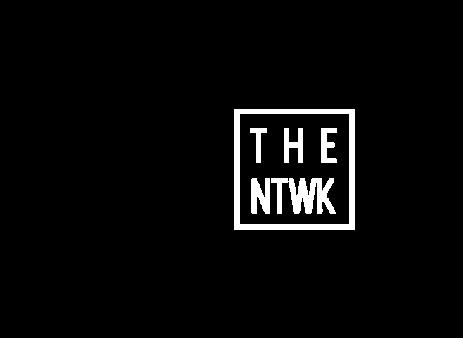
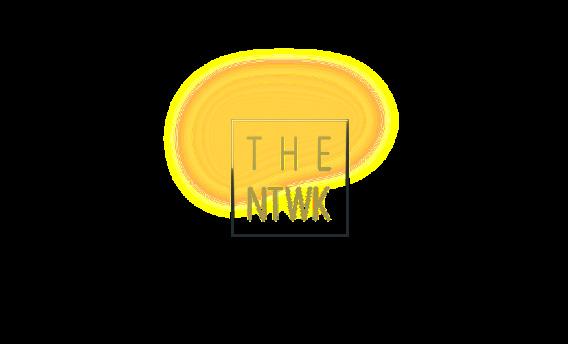
As the crypto market is really unstable and most NFTs today are bought with Ethereum. So what happens if that currency collapses or is folded into another, or is considered illegal in the future?
People who have tried investing in cryptocurrencies didn’t always have the best experience because of the security breaches and theft of tokens. That could also mean that NFTs did not receive the trust that would be required to really develop the overall NFT business


Another problem is that people still believe that it’s more of a niche, where it can be extremely successful because those niches are already used for virtual products, like gaming.
In the end, it’s a matter of language and comprehension and, as long as people need to know all the steps and technicalities, it’s not going to go to the masses. NFT projects are often just a single artist or small team juggling multiple interests at once. Having partnership goals that are specific, measurable, achievable, relevant, and time-bound can help make the most of a project’s time.
Regarding the artistic part of NFTs, there is an infinite number of art pieces that can be created. Adding the fact that making a copy of a digital piece of art is simple and fast. The speculation will be a tough topic to overcome. This problem has nothing to do with technology and everything to do with human psychology; it is the perception of luxury, ego and bragging rights.
Milja Van Noordende Strategist North&“NFTs need to be automatically embedded in what people do before they are truly scalable. For example, Starbucks doesn’t say that their loyalty program has anything to do with NFTs, and that’s really smart.“

From a tax perspective, there could be implications from both direct and indirect taxation depending on the laws of the country. Some of the applicable taxes could be:
Fig 23 - Source:
“Taxation of virtual assets” | October 2022 VAT implication on non-fungible tokens may not be the same as that of cryptocurrency. In Spain ruling V0482-22, of March 10, 2022; issued by the Spanish General Directorate of Taxes (Dirección General de Tributos), the transfer of NFTs was regarded as “supply of services.” Per the ruling, VAT was accorded similar treatment as that of “electronically supplied goods.” In India, NFTs are included in the definition of Virtual Digital Assets.
Some policy issues:
• Valuation of cryptocurrencies for determining the cost basis for tax purposes. The practice varies amongst countries.
• Cost basis in cases of gift or inheritance.
• Withholding tax issues where applicable in case of payments to non-residents.
Some steps that can be taken by policy makers:
• Simplified compliance mechanism.
• Clear guidance on taxable transactions and other matters.
• Time-to-time review of the policy in light of the emerging variants of tokens and use cases.
Source: https://nupurjalan.com/wp-content/ uploads/2022/10/Taxation-of-Virtual-Digital-Assets-. pdf
• Digital transformation sped up during the pandemic.
• The convergence of social and technological drivers is blurring the boundaries between our physical and digital worlds
• A new era of experience design that is not only human-centered but inclusive.
• Web3 as a game changer.
• The four key marketing shifts for brands: Communications, Sales, Community & Measurement.
• NFTs have the potential to dramatically change how brands create experiences, deliver value, reward fans, and conduct marketing campaigns.
• Omnichannel customer experience is an approach that seeks to enhance the brand experience by creating seamless, integrated, end-to-end customer journeys.
• Customer journeys become exploratory rather than linear.
• Omnichannel now includes metaverse and Web3.
• Early adopter brands in the metaverse are experimenting with the design of brand experiences.
• Engaging consumers with immersive technologies.
• Key learnings about metaverse experiences: Second Life (Web2), Spatial (Web2.5), Nowhere (Web2.5) and The Sandbox (Web3).
• Over the past 20 years, platform business models have demonstrated powerful advantages over traditional pipeline businesses
• Experience platforms offer “time well spent.”
• Strategic collaboration drives value.
• A business based on recurring revenue models needs an effective strategy to retain customers and keep them loyal.
• Consumers are overrun with outdated, low-value, cookie-cutter loyalty programs
• NFTs can help create a sense of identity, emotional connection, community and ownership around the brand experience.
This section will examine six need-to-know digital trends that will have significant consequences for the design of brand experiences in 2023:
1. The shift to digital channels accelerated by the pandemic
2. The evolution of omnichannel engagement into virtual worlds
3. The rise of ecosystem-powered experience platforms
4. The impact of Web3 on brand experience strategy
5. The promise of metaverse worlds and immersive technologies
6. The imperative to rethink customer loyalty for a new era
Our objective is not to describe every possible technology trend or tool that bears on brand experience. This is a holistic overview of digital trends at the intersection of customer experience, marketing strategy, and digital business models. The trends we describe here are among the most useful and relevant for forward-thinking brands ranging from large corporations to startups. These are the key themes that will allow organizations of all sizes to approach brand experience design with the creativity and verve that customers, creators, partners and brand fans demand.
The COVID-19 pandemic that began in 2020 was unprecedented in its economic and social impact on a global scale. Nearly three years into the crisis, we can begin to appreciate how much our world has changed as a result. COVID-19 isolation, lockdowns, and restrictions on in-person activities drove consumers online and spurred new levels of engagement with digital channels. Ready or not, both public and private sectors were forced to adapt
to meet the demand and accelerate a shift to digital that was already underway. Digital and phygital experiences became more important than ever for connecting brands, customers, and partners in ecosystems of co-created value and exchange.
In this section, we’ll describe a convergence of social and technological drivers that are blurring the boundaries between our physical and digital worlds and creating new narratives for brand experience and engagement. We’ll advocate for a new era of experience design that is not only human-centered but inclusive. Virtual worlds and other online spaces are being designed that return control and agency to their users, reward creators, establish new economies and allow people to interact authentically in digital environments.
In the pandemic era, we’ve also seen how we can use technology in a more personal context and maintain our connections with each other even when we’re apart. We can see a vast space of opportunity to correct the excesses and harms of the Web2 era. We’re also beginning to see how Web3 and nascent metaverse worlds will change and enhance the conversation around brands and the design of intentional brand experiences.
Juan Campderà CEO Aktiva Brand Experience Design“People are calling for a connection of all the design approaches and the technology that brings them unique brand experiences.

Omnichannel customer experience is an approach that seeks to enhance the brand experience by creating seamless, integrated, end-to-end customer journeys regardless of the combination of touchpoints and communications channels used. As consumers increasingly adopt multiple online and offline channels to engage with brands, the customer journey becomes more complex, fragmented, and difficult to map. The more disjointed the customer’s experience across channels, the more unnecessary friction and lost opportunities result. Despite the obvious implementation challenges involved, a strong omnichannel strategy pays off with significantly higher customer engagement, conversion, and retention.
As noted in a recent Capgemini report on immersive experiences, a consumer may find a product of interest on a brand website, proceed to a virtual world in the metaverse to interact with - or even customize - the product, then order it online for delivery at home. Each of the touchpoints and the handoffs between them must be designed to follow in a way that is seamless, flowing, and intuitive for the customer to navigate. Brands should seek
to minimize customer effort while maximizing the rewards of engaging with the brand.
Brands must also understand that the Web2 era of marketing funnels and linear customer journeys is now being supplanted by new modalities that offer the customer more choice and more control than before. The balance of power between brands and customers is shifting as persuasion strategies give way to brand-authentic forms of collaboration and community activation. Influence will work in both directions as customers become invested in co-created brand experiences. As CMS Wire reports, “By extending the omnichannel customer experience to include the metaverse, empowering customers to maintain control of their data and creating emotionally positive experiences, brands are able to enhance customer loyalty and improve the customer experience.”
Finally, brands will need to consider extending their omnichannel strategy into the metaverse and blockchainenabled Web3 environments. This means reassessing their already complex customer journeys and understanding clearly where there are opportunities to add value, create engagement and influence customer decisions. So how can brands decide if it even makes sense to explore these opportunities via metaverse and/or Web3 projects?
The following three basic principles give brands a useful guide and starting point:
• Meet Customers Where They Are – Brands should begin by assessing whether their present customers are already participating in metaverse worlds or Web3enabled environments, for example by purchasing NFTs. This is a clear indication that brands should already be involved. Second in priority to present customers are target customers, including identified cohorts and groups representing future customers. If they show a strong interest in metaverse and Web3 then brands have a clear signal that they should begin to experiment and learn how to extend their omnichannel strategy.
• Align With Brand Identity and Values – One of the important goals of omnichannel strategy is to present a consistent and coherent brand image across all channels. A brand’s presence in the metaverse or Web3 should not represent a break with the existing brand identity and values. Brands will need to ask first if they can engage authentically with their customers in the metaverse or in Web3, and then ask if they do so in a way that aligns with existing brand values.
• Include the Human Touch in Digital – Pre-pandemic it was fairly typical to think of “real life” as something separate from what we do online. Now our physical and digital worlds have started blurring together, and not just for the technology crowd. Brands need to keep this continuum between physical and digital in mind and remember that the human touch still matters in digital. An empty metaverse is a sad and unwelcoming place for a customer expecting to interact with other human beings. Wherever a degree of personal attention would be valuable to the inperson experience, brands should ensure that it is also available in virtual environments.
Over the past 20 years, platform business models have demonstrated powerful advantages over traditional pipeline businesses that have allowed them to create value from interactions, harness network effects and grow exponentially. Many platform brands like Amazon and Uber have become household names that are now ubiquitous in our everyday lives. Compared with traditional business models, platforms enjoy more favorable cost structures, higher profit margins and an unsurpassed ability to scale.
McKinsey research suggests that more than 30% of global economic activity could be mediated by digital platforms in the next five years. In 2020, the World Economic Forum estimated that “70% of new value created in the economy over the next decade will be based on digitally enabled platform business models.” Platforms that orchestrate resources in the form of goods and services have become key drivers of economic growth the world over.

The Experience Economy arose in a similar timeframe, gaining recognition in the late 1990s with the publication of The Experience Economy by B. Joseph Pine II and James H. Gilmore. The authors describe a theory of the progression of economic value from an Agrarian Economy (extracts commodities) to an Industrial Economy (produces goods) to a Service Economy (delivers services) and then to an Experience Economy (stages experiences).
As each stage becomes more commoditized, namely undifferentiated and low-margin, businesses have to choose how to remain competitive. The most viable option is to differentiate by creating or enabling the higher-value experience offerings that customers prize and willingly pay a premium to acquire. In a recent update to the book, Pine and Gilmour introduce the concept of “time well spent” as a measure of how engaging and meaningful the experience is for the customer.
Joe Pine Co-founder Strategic Horizons“If it is worth have a sales associate in a retail store to work with an individual customer, then it is worth it to have a sales associate work directly with individual customers in a virtual world (and a chat, for that matter).“
Where the Platform Economy meets the Experience Economy, we see the emergence of experience platforms. Joe Pine writes that “Experience Platforms combine the power of platform business models with the recognition that experiences serve as the critical link between a company and its customers in an increasingly distractible and time-starved world.”
(Source: https://platformstrategyinstitute.com/experience-platforms/)
Experience platforms match experience providers with experience guests. They create more value by mobilizing an ecosystem of providers, partners and complementors to stage multi-dimensional experiences and thereby establish a competitive advantage through strategic collaboration.
Instead of simply selling products or services and optimizing for the customer experience, experience platforms flip the traditional CX paradigm on its head. They start by selling the desired experiences and with optional goods and services where there is potential to enhance or complement the experience. Experience platforms orchestrate memorable events and experiences for their customers in which the memory, the effect or the transformation becomes the product.
Even before the pandemic, there had been a noticeable shift in consumer spending towards experiences. In 2017, the US Bureau of Economic Analysis and McKinsey analysts found that consumers had ramped up to 4x more spending on experiences rather than physical goods compared with recent years.
Source: https://www.mckinsey.com/industries/private-equity-and-principalinvestors/our-insights/cashing-in-on-the-us-experience-economy
The subsequent pandemic years caused severe disruption to people’s lives and their participation in the experience economy. Of necessity, some of that pent-up demand was swept up in the shift to digital and ultimately directed toward online experiences, adding an overtly digital dimension to the Experience Economy. The Experience Economy space has expanded to include offline, online, and hybrid experiences. The objective is not to replace in-person experiences, but rather to enhance and expand the opportunities to access experiences while attracting new customers and creating new revenue streams.
Web3 is touted as the next iteration of the internet following Web1 (1990-2003) and Web2 (2004-2020). What does this mean for brands and why is it such a gamechanger for brand experiences?
Since roughly 2021 we’ve been transitioning from Web2 to Web3. The Web2 era gave rise to big social media platforms, user-generated content, and influencer marketing. Web2 also delivered major privacy violations, exploitation of user data and an explosion of misinformation, propaganda, and conspiracy theories. The result was real-world negative consequences on a massive scale. A few tech companies
became incredibly powerful during this time, generating massive wealth for the few while entrenching inequity.
Web3 is meant to address some of these issues. The basic idea is that Web3 will be built on secure, blockchainenabled decentralized applications that support a token economy of user-owned and controlled crypto assets and data. Instead of competing for customer attention, the Web3 paradigm is a shift toward competing for loyalty and investment from individuals as well as communities.
Web3 culture values authenticity, inclusion, transparency, equality of access and decentralization. Participation and trust grease the wheels of Web3 because collaboration, co-creation and community are fundamental to how it works.
Justin Peyton of Brand N3xt describes four fundamental shifts that brands will need to understand in order to succeed in Web3 environments:
Brands can no longer count on having a captive audience of passive consumers. The power of brand storytelling is waning as younger consumers tap into “main character energy” and opt for becoming the protagonist in their own stories. The role of the brand is to win participation, not just attention, by showing what the brand can offer to the stories people are creating for themselves.
Traditional marketing ends at the bottom of the funnel when a customer converts (makes a purchase). This makes the sale both the objective and end of the transaction. The tokenized assets of Web3 change all of that. The token purchase is the starting point in a longer-term and evolving brand relationship where the token functions as both an asset and a communications medium. Brands can use tokenized experiences to engage and interact with fans while offering value in a personalized and meaningful way.
In Web2 environments, the word community is often misused as a synonym for customers, audience or followers. Brands would extract value from the community via data capture and extraction.
In contrast, community in Web3 is a choice underscored by investment, active participation and identity. Brands will become equal partners in the communities they are building and add compelling long-term value in exchange for the data the customer provides by connecting their wallet.
Web2 metrics are characterized by short-term measures of engagement and influence in order to effect realtime optimization, personalization and other kinds of time-sensitive efficiencies. The nature of Web3 inclines toward a longer-term outlook on brand experiences and participation which may require the development of new KPIs and analytical tools.
In Web3-enabled environments, NFTs have the potential to dramatically change how brands create experiences, deliver value, reward fans, and conduct marketing campaigns. In order to unlock the vast possibilities that NFTs represent, brands will need to experiment with different use cases and find the right balance of tangible value and utility. While there is still a place for NFT collectibles with intangible value – usually some form of prestige – brands should heed the lessons of last year’s crypto crash and avoid building brand relationships on the back of speculative assets.
In August 2022, marketing publication The Drum issued an opinion piece calling on brands to rethink the purpose of NFTs:
“If we stop treating NFTs like a cheap gimmick and instead focus on the practical utility and experiences they can deliver, we can inch a bit closer to unlocking their true potential.”
Source: The Drum, opinion (https://www.thedrum. com/opinion/2022/07/29/it-s-timerethink-the-purpose-nfts)
In particular, The Drum highlighted how NFTs could be issued to offer a premium, experiential layer that provides unique VIP benefits and exclusive, tokengated experiences.
Peter C. Evans describes NFTs as an experimental crucible for forward-thinking brands: “Over the medium term, it is reasonable to assume that there will be significant innovation around NFT marketplaces and the way they bundle customer rewards and experiences.”
Source: Platform Professional (https:// platformprofessional.substack.com/p/brand-nft-design-and-platform-strategy/)
Evans also identifies a key development for marketers as well-designed NFT projects attract robust interest and become substantial moneymakers in their own right. This transforms marketing departments from cost centers reliant on paid media to a font of new revenue streams.
Peter C. Evans Chief Strategy Officer McFadyen Digital
“Instead of paying an agency to promote a product or general brand building, brands can generate millions in revenue to fund engagement campaigns that gain additional energy and creativity by decentralized ownership of the NFTs.“
Source: Platform Professional (https://platformprofessional.substack.com/p/brandnft-design-and-platform-strategy/)
Fig 30 - Source: Balthazar, DappRadar | December 2022The metaverse is part of an ongoing process of technologies becoming increasingly integral to our lives. This trend has only accelerated during the global pandemic. Not only was there a huge consumer shift to digital for everyday activities like working, studying, shopping and socializing, there was also increased exploration of new digital spaces like online games and other virtual environments. When we couldn’t meet in person, we found new and varied
ways to congregate and interact with each other online. As of 2023, there is no single metaverse in the style of Snow Crash and no one company can claim to own it. What we have are a variety of metaverse-like virtual worlds; each of them experimenting, learning and reiterating experience design as they go along. Likewise, early adopter brands already present in the metaverse are experimenting with the design of brand experiences: they’re starting small, taking risks, pivoting as needed, and figuring out what resonates with the consumers, fans and creators they want to engage with.
During the pandemic, online gaming environments like Roblox and Fortnight hosted concerts by popular artists that attracted tens of millions of attendees. Gucci has been selling virtual goods on Roblox, with one of their digital bags reselling for more than US$4,000, well over the retail price of the bag in real life. The Nikeland store in Roblox has already attracted over 7 million visitors. This represents a huge opportunity space to connect with consumers – particularly Gen Z and Gen Alpha – and build brand affiliation through engaging immersive experiences.
Virtual Reality (VR) is what we normally associate with the metaverse. VR is an immersive technology that allows users to explore and interact in 3D computer-generated environments. With today’s technology, this requires some
kind of head-mounted device like the Oculus Rift. VR is now moving from the fringes to the mainstream. Nearly 90 million Americans are expected to use virtual reality this year. By 2025, it’s expected to be 110 million or more.
VR has gotten extremely popular through gaming but holds the promise of huge impact in many other domains. Improvements in virtual reality technology and hardware give immediacy and a powerful sense of 3D presence for teaching and learning, rehearsing skills, demonstrating products and services, virtual tours and even recruitment. In the near term, high costs and technical requirements may keep VR in the niche category for all but early adopter consumers and innovative enterprise applications.
| May 2022
Fig 31 - Source: New Trend Report “Into the Metaverse” (Wunderman Thompson); Value Creation in the Metaverse (McKinsey) | June 2022 Fig 32 - Source: World Economic Forum “How enthusiastic is your country about the rise of the metaverse?“Mixed reality (MR) means technologies that fuse virtual reality with physical reality and also allow them to interact. Mixed reality uses input from the physical environment to affect the user’s experience in virtual. For example, haptic technology recreates the sensation of touch in metaverse games and worlds. Emerge.io has created the world’s first device that uses ultrasound to simulate the sensation of touch in virtual environments. Instead of just seeing and hearing, we can also feel virtual experiences. User reaction to haptic devices from Emerge.io has been positive and enthusiastic suggesting that there is consumer demand for more life-like, multi-sensory immersive experiences.
Emerge.io founder Isaac Castro García is a fierce advocate of putting humans, not technology, at the center of design:
“Social media has exposed the perils of technology designed without humans at the center, and its harmful effects on our mental health and emotional wellness. We’re missing what we removed from our interactions a decade ago: humanity, intimacy, depth, and empathy. Real conversations instead of mass influence. Interactions that make us feel closer to each other. In the future, our focus will be on the human experience. The transition to the metaverse will be not a technological but a sociological paradigm shift.”
Source: World Economic Forum (https://www.weforum.org/agenda/2022/05/17ways-technology-could-change-the-world-by-2027/)
Augmented Reality (AR) contrasts with VR and MR in the sense that it is not fully immersive. Rather, it adds a digital layer to a live view from a smartphone or tablet camera. AR has tremendous potential to merge physical and digital into a unified, everyday phygital experience. Popular mobile games like Pokémon Go and social apps like SnapChat filters have already made the case for AR uptake in the domain of fun and leisure.
This digital layer doesn’t have to be cute animations either. Imagine having a persistent information and utility layer on top of reality that engages with your location and goals in real-time. Brands should take note that 71% of customers say that they would shop more often if they could use augmented reality. Retailers could use

AR to offer additional, dynamic brand content; stage product demonstrations; or give consumers a memorable experience of the product before purchase.
Many more practical applications are sure to follow in the coming years. With 6.6 billion smartphone users globally and 83% penetration as of 2022, the ubiquity of smartphones makes AR one of the more exciting areas of immersive technology.
Returning our attention to the metaverse proper, brands should keep in mind that the word “metaverse” does not automatically imply Web3 capabilities. Many of the most popular, high-traffic metaverse worlds to date are Web2 centralized platforms. The oldest of these, Second Life, was launched nearly twenty years ago with avatars (legs included), a marketplace for digital goods and real estate, and its own in-game economy. Today some of the newest metaverse worlds are blockchain-enabled and Web3ready, and others are Web2 but feature optional Web3 integrations that allow users to connect their wallet, buy NFTs and create token-gated events and spaces. The term Web2.5 has emerged to describe this trend of Web 2 metaverse worlds with Web3 integrations.
Source: Meet Global (https://meet-global.bnext.com.tw/articles/view/47768)
Anna Noakes Schulze Head of Community Experience TheNTWK
“The metaverse isn’t just a fad. It’s the greatest experimental space for experience design we have ever seen.“
Continue reading to find out the Key Learnings for Metaverse Experiences:
• Second Life (Web2)
• Spatial (Web2.5)
• Nowhere (Web2.5)
• The Sandbox (Web3)
Picture 2 - Source: AdobeStock via Handelsblatt | October 2022 (https://www.handelsblatt.com/adv/firmen/augmented-reality-app.html)Second Life was founded in 2003 and at peak popularity had over a million users, called residents. Even now after nearly 20 years, there are still about 600,000 monthly active users and 200,000 daily active users.
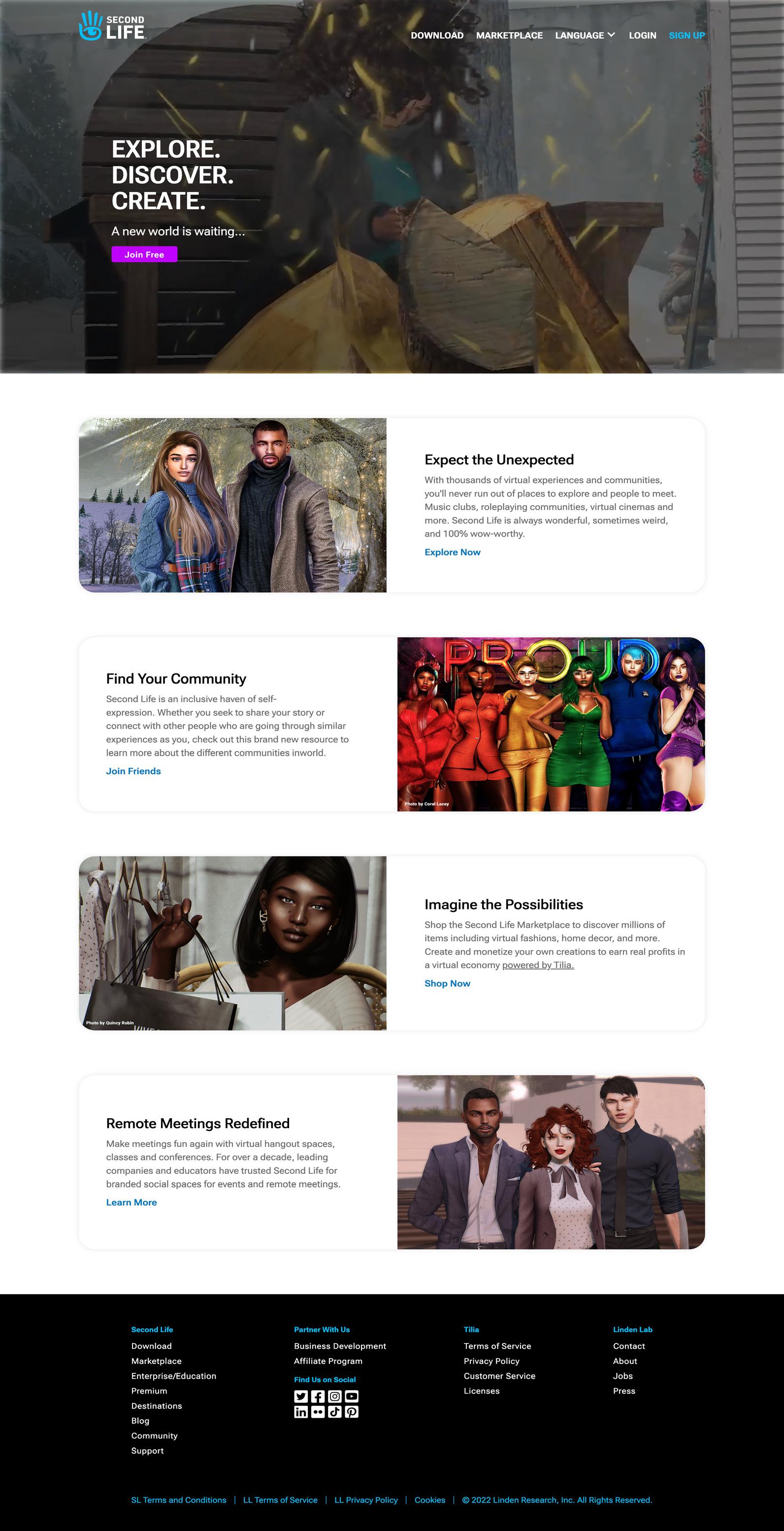
Second Life was ahead of its time and even now it’s hard to overstate just how ground-breaking it was. What they realized very early on was the power of communities and building social cohesion through tolerance and respect. That meant creating a welcoming environment with clear guidelines and tone-setting that attracted diverse and engaged residents from all walks of life.
Wagner James Au was an embedded reporter during the early days of Second Life. He notes that interacting with other people in virtual worlds creates a sense of real human engagement that social media has failed to achieve. Avatars allowed residents to express themselves as they wished and experiment with digital identity. In a 2002 interview published in The Atlantic, Au commented on the ability of metaverse users to design their own world:
“If you give a user community powerful enough creator tools, what they create in these worlds will be far more interesting than anything a major company can officially create… I think the big battle going forward will be between these different platforms with different visions for what digital life should and could be. I just hope the humancentered ones win out.”
Source: The Atlantic Newsletter (https:// newsletters.theatlantic.com/galaxybrain/6233ecafdc551a002089fb15/lessonsfrom-19-years-in-the-metaverse/)
Spatial was designed with cultural events and exhibitions in mind so it’s visually gorgeous. It offers artist-built customizable meeting place templates that allow users to host events and create virtual experiences. Spatial was originally intended for corporate collaborations but the global pandemic uncovered new use cases that hadn’t been part of the plan.
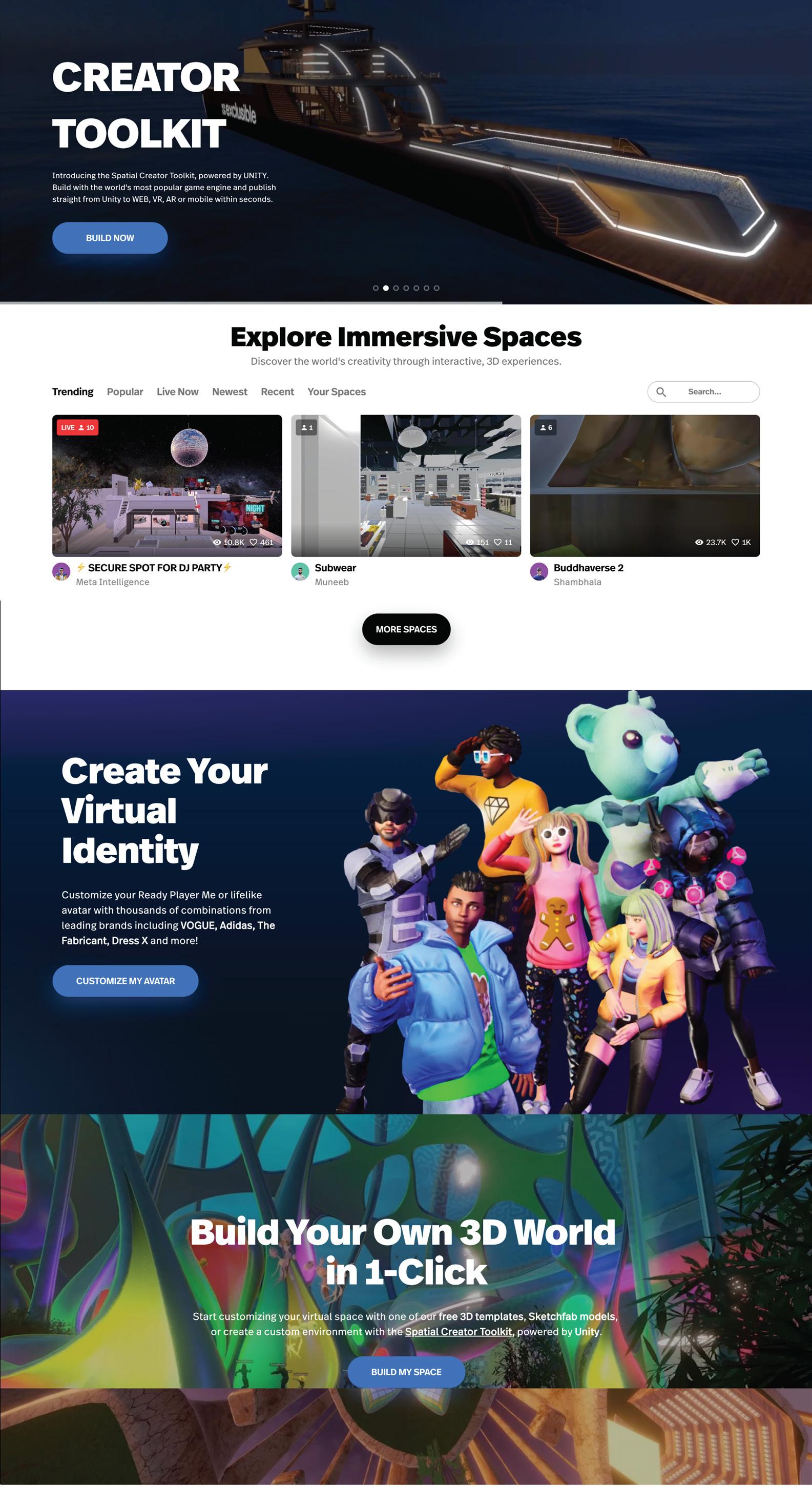
The COVID-19 lockdowns forced more people to find virtual solutions for nearly every aspect of life. Jacob Loewenstein, Spatial’s VP of Business Development and Strategy said the company began to notice the novel ways people were using the platform: “What immediately started happening was, we had these unexpected growth use cases: galleries for art, social meetups, universities using our free version to teach courses.”
Going with the flow was essential to letting users co-create the experiences they needed and wanted. “Here we are, overeducated overthinkers, trying to spell out what the metaverse should be,” Loewenstein said. “Our users ended up showing us what the metaverse is. It turned out that these basic tools we’ve built, a lifelike avatar, joining from any device, and customizing any environment — those all actually allow people to interact with each other in a lot of different contexts.”
Source: Freethink (https://www.freethink.com/ hard-tech/spatial-metaverse)
Spatial – Pandemic Powered Metaverse Co-Creation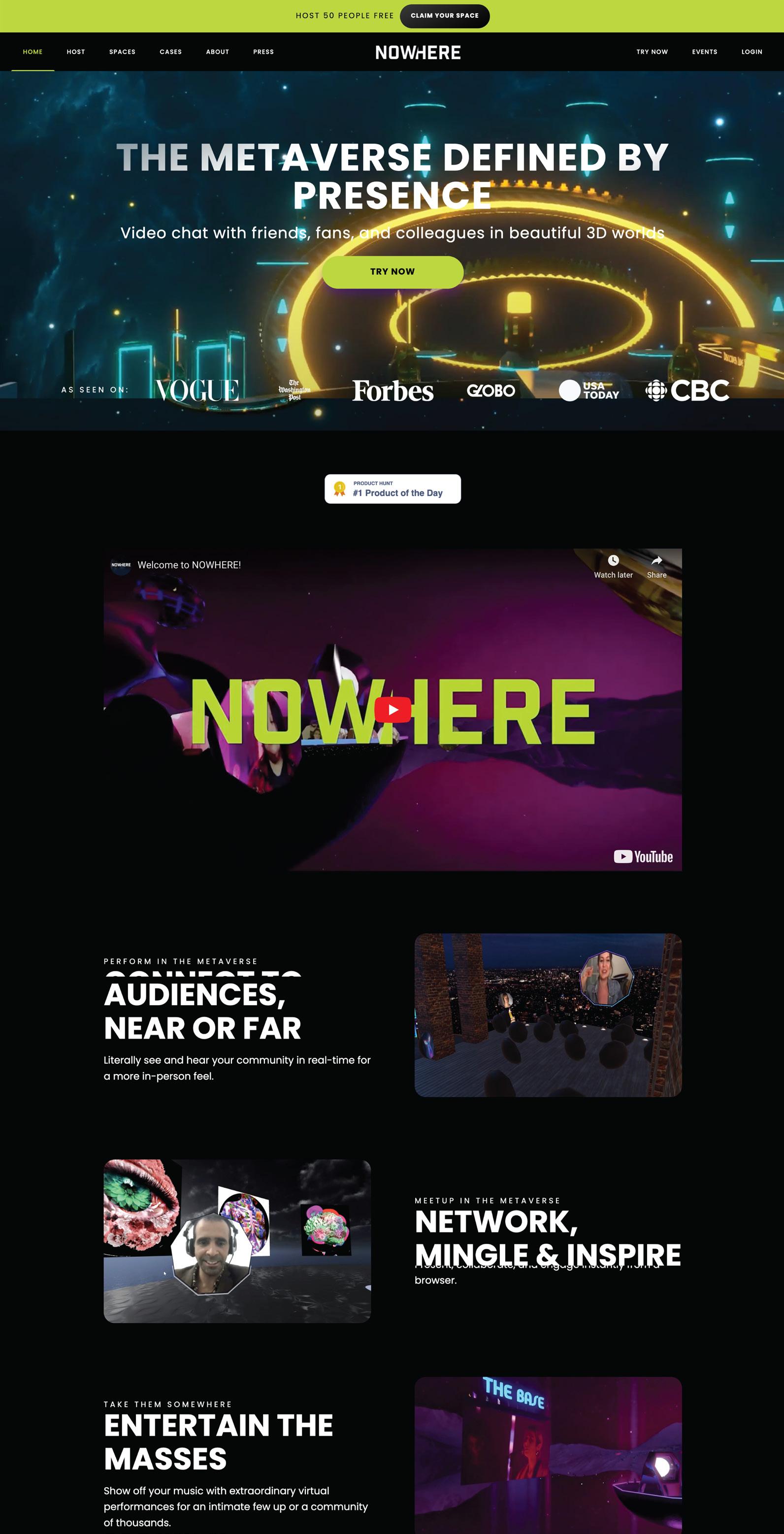
NOWHERE is an accessible metaverse environment that is low-tech by choice. The core idea is to lower the technical and financial obstacles of participating in the metaverse. This means that people living in less-developed countries or just having less powerful computers and devices can still participate and experience the building blocks of the metaverse. Cofounder Ana Constantino says, “anyone with a link and a click can come in.”
Source: AdAge (https://adage.com/article/ digital-marketing-ad-tech-news/inequitymetaverse-how-brands-can-prioritizemulticultural-marketing-virtual-worlds/2409471)
Instead of requiring an avatar, users use their camera feed to generate a real image within a nonagon frame. The nonagon can then travel around NOWHERE’s spaces using simple keyboard controls. Although cameras can be switched off or appearances changed using camera filters, users enjoy the feeling of presence they get from seeing real faces and interacting as themselves. NOWHERE has video on by default as a deliberate design decision: “The developers feel that inconsistent use of video creates an imbalance in social dynamics and that having cameras on by default helps support healthy online spaces.”
Source: The Enterprisers Project (https:// enterprisersproject.com/article/2022/2/4metaverse-tools-workplace-collaboration)
Despite the low-tech approach NOWHERE also offers some Web3 integrations. It can link to users’ crypto wallets if they have one, but it’s not required. It can also implement token-gating to create private spaces for things like corporate events. Google, Salesforce and CoinDesk employees have all held meetups in NOWHERE.
The Sandbox is a fully Web3 decentralized metaverse game built on the Ethereum blockchain. Users can buy LAND as NFTs that they can customize and monetize. Multiple LANDS can be purchased to form estates and even districts. Some of the notable names already building on The Sandbox include Atari and the Bored Ape Yacht Club. American rapper Snoop Dogg built a replica of his home in The Sandbox and plans to host live performances from the digital mansion.
In an interview with CX Network, Sébastien Borget, COO and Founder of The Sandbox discussed how the metaverse enables new ways of delivering brand experiences:
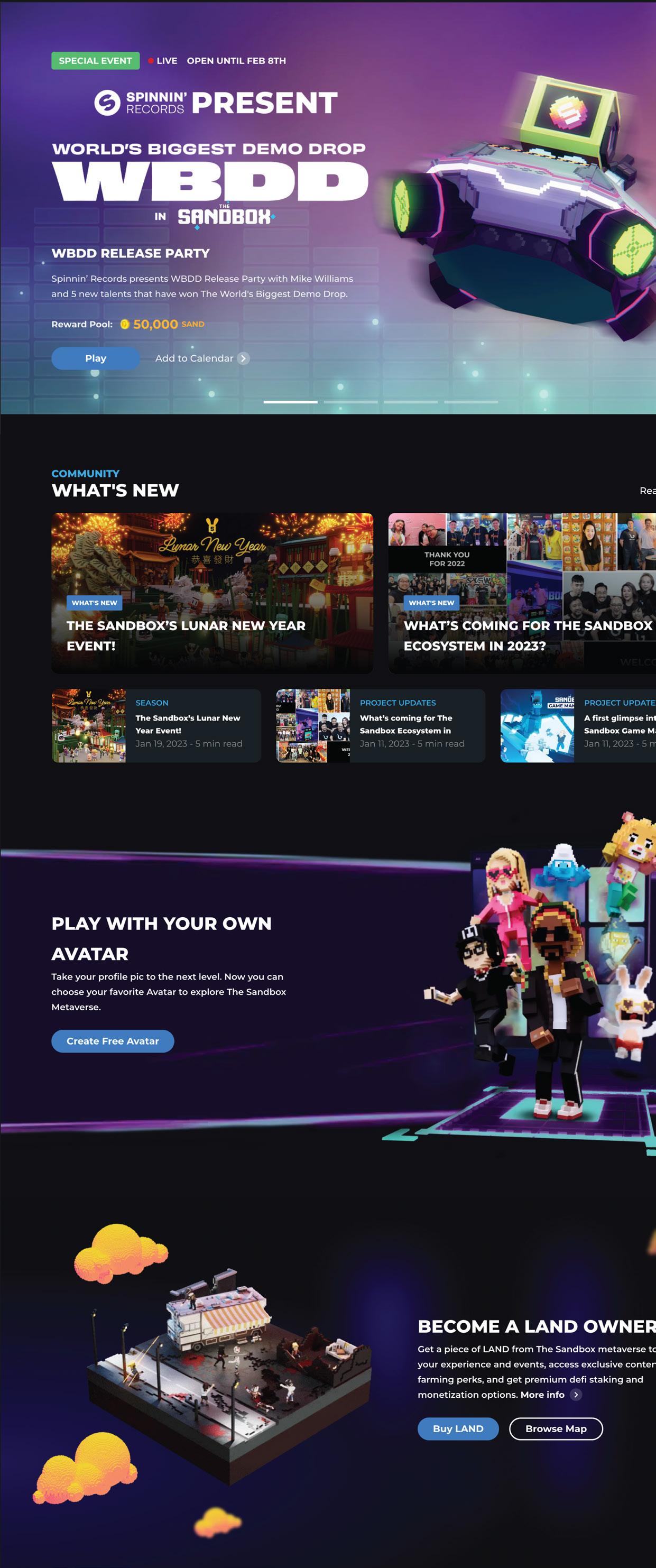
“We are seeing the brand-customer relationship evolve before our eyes. It is no longer transactional but focuses on creativity and a sense of innovation and experimentation. Brands are reinventing themselves to give more value to their fans and customers, and providing experiences that offer a better sense of community is a powerful tool for doing so.
Giving perks to your customers or putting on live events strengthens your brand. The metaverse and non-fungible tokens (NFTs) fit perfectly into this strategy, and customer experiences can even be maximized with play-and-earn features that reward customers for their time in the form of tokens and value they can exchange.
The metaverse allows brands to host virtual events in lieu of, or to complement, physical events, expanding their options greatly. In the metaverse, geographical limitations do not matter, making it easier to reach a larger audience simultaneously, pushing through the limits of our imagination and creating real emotions, thanks to technology.”
Source: CX Network (https://www.cxnetwork.com/cx-technology/interviews/ how-the-metaverse-will-change-the-way-we-deliver-customer-experiences)
By now it should be clear that the metaverse isn’t really a thing or even a place. It’s an idea and a set of aspirations for the future of human interactions in 3D virtual immersive spaces. Well-designed metaverse experiences have the power to engage users with entertaining and rewarding experiences that foster connections between brands, consumers, creators and fans. The pandemic taught us that real human contact still matters. But it also taught us that we could find a place of connection, fun, and fulfillment online as well.
While gaming is the tip of the spear in metaverse development, the metaverse is more than a game and much more than a virtual playground for kids. The metaverse represents a thrilling convergence of art and design, technology, user experience, psychology, social values, economics, entertainment, connection, and community. In other words, it’s the greatest experimental space for experience design that we have ever seen.
Customer loyalty is big business. In the United States alone, businesses lose US$136.8 billion yearly due to poor customer retention. (Source: Call Miner, https://techjury.net/blog/ customer-loyalty-statistics/) For any business based on recurring revenue models, such as memberships, subscriptions or software as a service (SaaS), survival is simply not possible without an effective strategy to retain customers and keep them loyal. Other kinds of businesses can also generate substantial benefits from even small changes in customer retention. A Harvard study found that a 5% increase in customer retention rates increases profits by 25%-95%.
(Source: Harvard Business School, The Economics of E-Loyalty, https://hbswk.hbs. edu/archive/the-economics-of-e-loyalty)
Other research into the effects of retention and loyalty on customer behavior and profitability make the case compellingly clear:
Source: Annex Cloud (https://www.annexcloud.com/blog/10-pros-and-cons-ofloyalty-programs/)
• Retention is much more cost-effective than acquisition – new customer acquisition is 5x more costly than selling to existing customers
• Repeat customers are more profitable – loyal customers buy 90% more frequently, spend 60% more per transaction, and deliver 23% more revenue and profitability
• Loyal customers generate positive word of mouth – a source of free, trusted marketing
• Loyal customers refer new business – people are strongly influenced by referrals from family and friends
• Referrals are more profitable than other new customers – tend to have a much shorter and cheaper sales cycle
• Retention improves CLV (customer lifetime value) – also reduces customer churn
Loyalty programs are a time-honored solution that brands have leveraged over the decades to influence customer behavior, generate repeat business, encourage retention, and keep customers at least outwardly loyal. Globally, loyalty marketing spend is expected to grow at a 12.6%
CAGR (compound annual growth rate), demonstrating the priority that brands put on relationship marketing.
Source: Brand N3xt (https://brandn3xt.substack.com/p/from-short-termism-tolongevity-why)
The trouble is that most customers don’t see the value of these loyalty programs. Consumers are overrun with outdated, low-value, cookie-cutter loyalty programs that inconvenience them, cost time and effort, and offer rewards they don’t need or want. Most loyalty programs are more trouble than they are worth from the customer perspective. Harvard Business Review goes as far as to call loyalty programs “lazy” – as they only seek to bribe the customer – and then identifies the crux of the problem as follows:
“The irony of most of today’s customer loyalty programs is that they aren’t about loyalty at all. They have more to do with an economic transaction than with true affinity for a brand. True loyalty is emotional and irrational and leads to customers feeling like they’re part of an exclusive membership group…In the modern aspiration economy, people develop true brand affinity only when it gives them a sense of community. Done right, membership strategies are an effective way to achieve that goal.”
Source: Harvard Business Review (https://hbr.org/2021/02/want-more-loyalcustomers-offer-a-community-not-rewards)
Loyalty programs are in need of a radical overhaul not only in terms of how they are designed and structured but also in terms of how they build relationships between brands and customers. Web3 has unique features and qualities that will give brands the opportunity to reimagine mechanisms of customer loyalty from the ground up with NFTs as the currency of choice.
NFTs can help create a sense of identity, emotional connection, community and ownership around the brand experience. They can be tailored and personalized in a way that makes the customer feel appreciated for their choice to engage with the brand. They can move the needle from passive consumers to enthusiastic fans and brand advocates. Finally, loyalty programs built around NFTs offer the chance to overcome the present short-term fixation on capturing customer attention and create new modalities for longer-term customer participation instead.
Source: Brand N3xt (https://brandn3xt.substack. com/p/from-short-termism-to-longevity-why)
So how should brands deploy NFTs to enhance brand experiences and promote loyalty? A good starting point is to understand how different NFT classes or attributes combine to influence perceived value, emotional impact and customer behaviors. Different types of NFTs will suit different brand goals and desired outcomes.
Static NFTs. The earliest iterations of branded NFT projects were trendy digital artworks and collectibles in the form of static NFTs. These NFTs were fixed and unchanging. They offered intangible value stemming from perceived rarity, desirability or prestige. This made them speculative assets with tremendous price volatility (usually downward). Many collectors and brand fans were disappointed to find that NFTs with intangible value only made poor investments.
NFTs with Utility. Brands and customers quickly found a stable and lasting source of tangible value in NFTs designed with utility. Here, utility means that there are perks, privileges and benefits associated with NFT ownership that may span the virtual and physical worlds as well. Just to cite a few examples, utility could mean things like:
• Exclusive access to an owner/member community
• Tickets and passes to physical events, like concerts, meetups and parties
• Access to token-gated online spaces and events
• Additional NFT drops or even crypto coins in your wallet
• IP rights to monetize the NFT
• Brand collaboration opportunities
Adding utility gives NFTs the tangible value that makes them worth a higher price and also makes that price more likely to be stable over time. They can even grow in value depending on scarcity and additional perks or privileges that may be added. Utility provides brands with the opportunity to communicate and engage with their customers and fans on an ongoing basis and create strong brand loyalty.
NFTs with Interoperability. Interoperability is a way of structuring blockchain-enabled loyalty vehicles so that different programs can be interlinked. This not only offers more ways for customers to participate in related loyalty programs, it also allows brands, vendors and partners to leverage an ecosystem strategy that delivers a more varied and compelling array of loyalty rewards. The advantages of this approach are far-reaching:
“Customers could have the chance to interact with each other through their engagement with loyalty programs, sharing and combining points to potentially unlock experiences or discounts that wouldn’t normally be available. It could also remove potential barriers global brands have to connect loyalty programs across business operations, rewarding users across multiple markets.”
Source: The Drum (https://www.thedrum.com/opinion/2022/10/31/loyaltyprograms-are-broken-are-nfts-the-solution)
Dynamic NFTs. In contrast to static NFTs, dynamic NFTs are tokens that can evolve and change according to what the user does with them. Dynamic NFTs are designed for participation and reward the desired actions in ways that can upgrade the NFT, increasing its value and deepening the user’s investment in maintaining their NFT.
Composable NFTs. These are another blockchain innovation that allows artists, musicians, and collectors to embed extra utility within their NFTs. This creates layers
of value within the original NFT asset and allows the development of different creative narratives within the initial artwork or song. Creators can build a community around the work, even adding social tokens.
Alun Evans CEO Freeverse.io
“We’re seeing traction on the branding side of things, where brands are using these tokens as a new way of engagement and a new way of driving traffic.“
Collectors can also take advantage of NFT composability: “They can personalize the NFT further by embedding other NFTs, social tokens or even crypto within the work, allowing them to sell their NFT as a bundle. Some NFT platforms already offer component NFTs, with KnownOrigin being one of the first to adopt them.”
Source: NFT News Today (https://nftnewstoday.com/2022/10/15/many-artists-andmusicians-using-composable-nfts/)
Philanthropy NFTs. For charity or social impact go well beyond digital asset collection. They have the potential to be a force for good in the world and lend support to incredible causes that matter to brands and consumers. According to CoinTelegraph, in 2022 “communities have launched NFTs to raise support for causes like testicular cancer, human trafficking and the war in Ukraine. While many believe the NFT trend is finally on the path to sustainable growth, its potential as a tool for charities is poised to reach exciting new highs.” Source: Coin Telegraph ( https://cointelegraph.com/news/nfts-empowering-artists-and-charities-toembrace-the-digital-movement)
In summary, these various NFT types and attributes provide brands with a powerful set of tools for engaging with customers, projects and causes. They can help identify superfans, offer perks and rewards, incentivise desired actions and behaviors, encourage loyalty, and build communities around brand purpose and values.
The global shift from physical to digital flows both ways. Since the onset of the pandemic in 2020, digital experiences have become more important than ever for connecting brands and consumers. Concurrently, we reaffirmed the importance of the human connection, the joy of our in-person interactions, and the necessity of hybrid modalities for living, learning and working in a phygital world. The trends we described here all have the potential to breathe new life into brand experiences and reconfigure the opportunity space for value creation, collaboration, engagement and loyalty, while attracting new customers and generating new and novel revenue streams.
• Invest into developing a collaborative culture. This can be achieved with right tools and clearly defined goal.
• A key element of the ecosystem shift is the customer’s engagement as an active participant in the creation and definition of your services/products catalog.
• Your partners need to have confidence in your intentions, both to your customers and theirs.
• Startups and corporations are operating within the same ecosystem, their collaboration creates opportuntities to improve time to market delivery and quality of the overall Customer Experience.
• They’re complementary in some way; the strength of an incumbent is the weakness of a startup.
• The established market players, even if they managed to disrupt market once, should invest in innovation to stay on the top of their game and remain relevant to the market.
• The healthcare across Europe requires more collaboration of resources such as new apps and technologies, administrative data, test results, etc.
• There is a potential in building a pan-European healthcare solutions that could be compliant with both scenarios.
• In some cases, governments are the payer and they can choose to either set up the system or at least have a lot of control over the structure; who gets to participate, and what the rules are. In other cases, a private ecosystem allow to fix pain points of public system without governments participation.
• What Does TheNTWK Community Say?
• Bancolombia Ecosystem Case Study

“We
Julian Kawohl Professor Strategic Management Founder Ecosystemizer“In this seamless integration, there are multiple companies, and value creation, which are for me the key components of ecosystems offerings.“

intentionally look at operating models that bring together, dedicated and affiliated organizations and resources that are aligned around a shared vision, a shared purpose, a shared cause, or shared effort.“Fig 34 - Source: TheNTWK Survey | October 2022
The emergence of ecosystems shifts value away from conventionally vertically integrated company structures and toward horizontal business models. These business models are sometimes referred to as multi-sided platforms since they produce value by managing interactions among many sorts of stakeholders across the ecosystem.
Miriam Van Straelen Partner Roland Berger
Effective collaboration can have an overwhelmingly positive impact on employee engagement, well-being, and productivity. Three essential elements of a collaborative business include:
• A collaborative culture
• The right tools
• Clearly defined goals
As a general principle, you have to add more than you take. We first need to ask ourselves what we can do for all of the various users, not just our consumer users, but also our ecosystem partners. We need to get the value proposition to any specific type of user. Otherwise, you can end up driving those partners away, which is the last thing you want to do. We’re in a competitive environment, so we have to give the parties a reason to be with us and collaborate
The most efficient strategy to find a feasible ecosystem opportunity is to study the customer journey and identify market frictions; frustrations, unmet requirements, and unfulfilled desires. The next question should be: Are these market frictions too large or complicated for one firm to manage on its own? When you’ve identified a compelling market opportunity and value offer, consider if an ecosystem is the best method to provide the solution. Finally, ask yourself what you can do to help
with the solution, and which crucial assets and competencies can be used (such as data) that may be valuable in another’s ecosystem.
The ecosystems’ roles also deserve a mention to figure out which role a company can play. It’s important for companies to understand their current position and future positioning options to participate in and/or build ecosystems. In this case, players can be categorized into three possible roles depending on their relationship with the final customer: Orchestrators, Realizers, and Enablers.
Sangeet Paul Choudary Founder Platformation Labs“In an ecosystem, we typically see three types of horizontal business models emergeAggregators, Integrators, and Infrastructures - which may be distinguished based on their position in the value chain. Additionally, firms may specialize and act as capability providers.“
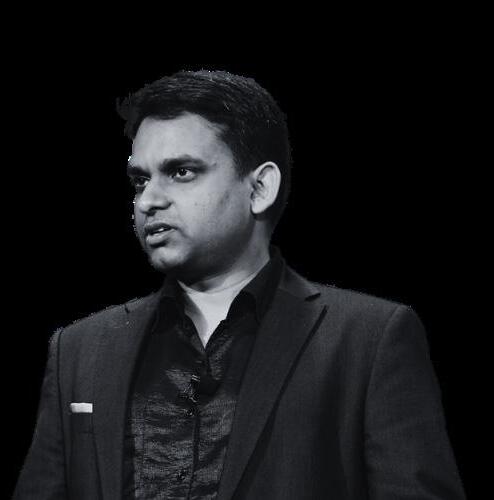
“Cooperation and collaboration are key in any kind of ecosystem. Focusing on win-wins rather than a competitive advantages will allow you to grow the size of the overall opportunity and thereby adding more value for your clients or customers.“Jeroen Ermers Product Owner, Platform, Ecosystem & Strategy Services Cegeka

“A company like Siemens in Germany is an ecosystem orchestrator. They collaborate with all kinds of partners and suppliers leveraging their collective resources and expertise, making it very difficult for other companies who are not part of this ecosystem to compete in this arena. “
The Ecosystemizer team designed The Ecosystem Strategy Map, which can then be used for ecosystem design together with other tools to identify new partners and craft ecosystem offerings. It can be further used to strategize the best positioning moves and develop the target positioning as the foundation of an ecosystem strategy.
• Analyze
1. The current positioning of your company
2. The current positioning of your clients
3. Competitive environment
4. Partnerships
5. Socio-economical, technological and regulatory trends
• Strategize
1. Ecosystem strategies and positioning moves
2. Business impact (of positioning) and target positioning
• Design
1. Identify new partnering options (together with other tools)
2. Offerings and value propositions (together with other tools)
We see sectors that are predominated by big brands. For example, Adidas and Gucci are collaborating but that’s not an ecosystem; that’s more like a punctual collaboration. Retail is going to be very difficult because they already profit in their own ecosystems within their brand families, they’re already profiting from supply chain collaboration. In travel, for example,
we have got local, regional, and international travel. We’re already seeing a bit of collaboration and joint ecosystems just to make the end-to-end travel experience for consumers a better one. The more commoditized a business is, the more they have to provide value through complementary services.
Marta Agrech Digital Transformation & Innovation Manager Sopra Steria Next
“In order to shift towards the ecosystem economy you need two main paradigm shifts within your company’s strategy: customer’s needs vision & partners engagement.“
Firstly, there is a necessity to consider customer needs generated by what we call a moment of life. “Nobody signs a real estate loan because they dream of taking a half day off to go to the bank and sign a lot of papers. We do it because we have a human need to buy a house for our family”, states Agrech.
A key element of the ecosystem shift is the customer’s engagement as an active participant in the creation and definition of your services/products catalog. You need to provide your customers with an opportunity to
express their needs, be content creators and inspire others with their own desires. This obviously requires more agile processes to be able to adapt quickly and listen to customers and partners very carefully.
Once you stop thinking exclusively about your own business, you start to think about how you can help your clients in their daily life, and naturally, you will need others to do so. “A person who buys a house will need maybe a moving company, construction team, interior designer etc. As a bank, you will not diversify your activity to cover all those needs. That is why the initial information, regarding buying a house, can give you an opportunity to engage other companies in answering your customer expectations in an ecosystemic way”, says Agrech.
This creates the opportunity to build offers with your partners and help them and yourself to grow. That is when you engage everyone in a positive cycle and obtain some really amazing outcomes. The multisided trust within the ecosystem is leveraged to create engagement. “When people believe you and have confidence in you, they want to do their best.” Your partners need to have confidence in your intentions of providing the best offer to address a moment of life in the most complete and coherent manner, both for your customers and theirs.
Given the high cost of innovation, many firms are beginning to recognize that partnering with start-ups might help them accelerate their time in the market, giving them a much-desired competitive advantage.
Simone Cicero CEO Boundaryless
contract that could be completed in a matter of months.
The incumbent has resources and assets, the startup is flexible
The mindsets are so different. An executive that has never been close to the startup world, cannot even understand that startups don’t have processes. As soon as they realize that this is not only a virtue but also could be their own barrier to change; the trick here is to understand how to work together. There is a good reason to have documented safety processes, risk management strategies, and due diligence. And, because technology moves so fast, it’s just really easy for big tech to think that they’re not beholden to that.
corporation. Making a lot of partnerships at the same time can be unproductive. The idea is to build incrementally.
• Addressing cultural gaps
Different companies, different cultures; even methodologies and philosophies.
• Having a common objective for this collaboration and defining certain KPIs that measure success. This will help to not get stuck in the middle of the project.
Mª Julia Prats Professor of Entrepreneurship IESE Business School
Traditionally, collaborations and ecosystems focused on “we know what we want.” An established firm, with this mentality, would develop precise specifications for the desired technology or product characteristic. Startups, on their side, are similarly obstinate in their pursuit of a huge corporate client and a
Established companies have a very good understanding and know the problems in the business. The startup comes sometimes without knowing the context, but they come in with fresh minds. It’s not about changing your business as a startup or as a traditional company. It’s more in the areas where you do not have much experience partnering, and maybe joining each other could be really meaningful.
To get the most value out of it, companies should approach this collaboration idea as follows:
• Bringing the A-team to the collaboration, and that goes for both the start-up and the
Corporations need to leverage more on external players. To do this, they need to learn and to give their teams more capability to manage their own product strategies, switching from functional organizational settings into product-centric ones. Smaller teams are able to structure internally with autonomy to replicate the outcomes that they want to generate on the market. Leave this freedom to reorganize around the product.
“They’re complementary in some way; the strength of an incumbent is the weakness of a startup.“
“Some companies don’t have the organizational capability to activate their teams and are also dealing with a shortage of specialists. For example, developers, security experts, product managers and growth specialists.“
Many of the firms that disrupted the market in the past century, have either gone bankrupt, merged, or still exist but have fallen. Even if big firms have disrupted the market once, they need to reinvent themselves Therefore operating a business is volatile and susceptible to external agencies and how innovation continues evolving.
One famous example is Nokia, the first company to create a cellular network in the world. In the late 1990s and early 2000s, Nokia was the global leader in mobile phones. How did they fail to innovate? The company overestimated the strength of its brand and believed it could arrive late to the smartphone race and still win. In 2008, one year after the first iPhone release, Nokia finally decided to compete with Android, but it was too late. Their products weren’t competitive enough
As a company, you can go through disruption once and drive it actively and then miss out on an important next change in your environment. Adapting once doesn’t give a guarantee of success. Some companies made some severe mistakes in the past and some even failed. Take a look at those who fail in order to understand what you should avoid and how to do better.


In conclusion, it’s easy to see why corporate partnerships with startups
make sense: start-ups can benefit from corporate funding, resources, and customer access, while corporations leverage collaboration with startups to innovate and stay ahead of competitors.
Oliver“What happened, for example, to companies like Nokia in the past, is that they made a disruptive change very successfully once, but at some point, they completely missed the train when it came to smartphone development.“
“Why redo things that some people know how to do, when the idea is rather to use what they know how to do to make something bigger, better or different? “
customers’ lives, thereby gaining a competitive edge. The process began investigating its clients’ broader circumstances, life phases and business procedures. As a result, they sought to provide a wide variety of financial and non-financial solutions to its clients rather than focusing just on banking services.
After exhaustive research based on data, the focus areas were:
• Everyday life activities: better savings, investment, and consumption decisions.
• Housing: and finance, as well as real estate analysis tools for developers.
To help them manage the transformation, Bancolombia leadership developed a set of starting principles:
1. Agile methodologies. Breaking the project into several phases. It involves constant collaboration and continuous improvement at every stage.
2. Cloud and open platforms Open platforms were developed in-house and run in the cloud.
3. Increase automation. Helped accomplish this autonomously.
4. Increase scalability. Tasks that had higher value for the bank.
Bancolombia is the largest commercial bank in Colombia and one of the largest in Latin America. Let’s see the implementation process of an ecosystem strategy and the launch of this “neobank” and which challenges brought Bancolombia’s traditional ways of working.
Bancolombia’s transition was motivated by being involved in supporting every area of its
• Mobility: finding, purchasing (or leasing), and insuring vehicles (cars, motorcycles, and bikes), as well as supporting smart and sustainable mobility modes.
Bancolombia’s shift to digital ecosystems necessitated the development of technology and a mindset shift to support them. Luis Miguel Zapata describes the biggest challenge as “changing the culture requires new goals, processes, values, roles, communications practices, attitudes, and assumptions.”
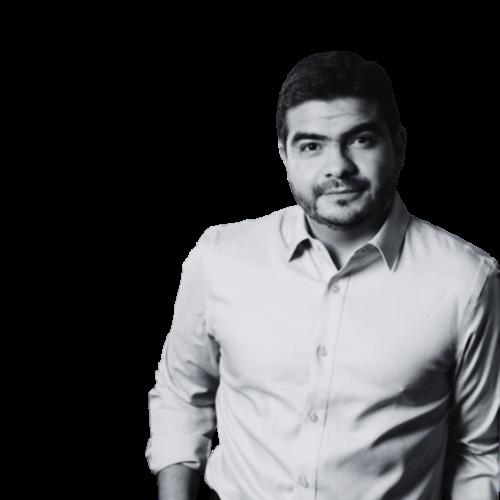
5. Advanced analytics and AI Ensure that decisions are based on data.
6. Cybersecurity. Key to ensuring privacy and supporting digital growth.
7. Open banking capabilities The ambition of becoming a central player in multiple digital ecosystems and promoting open innovation.
“It is a comprehensive experience in which you could solve your needs in one channel or in one integrated experience; it could be a mobile app, a web page, or a physical experience.“
Nequi arises as a corporate project of Bancolombia, which converges the market situation, the banking relationship with young people, and the opportunities of new technologies. Bancolombia separated a whole team that dedicated itself for a long time to understanding these main topics and solving all those gaps in the traditional financial system. The operation, the communication strategy, the commercial, operational and technological model of Bancolombia’s solutions were completely separated, and that is also part of the strategy, because banks have systems, priorities, and universal banking that has a number of projects and is evolving a lot, and developing these products to compete with solutions that are niche or fintech, which have a speed and agility, with those technologies it is a little more difficult.
As a 100% digital solution, it complements its offer with functionalities that go beyond saving and managing money. Nequi is much more than a digital wallet, it has an offer of Services that allows its users to pay with the Nequi Card, request loans, bring dollars through PayPal, pay utilities, recharge their cell phone, and even request a medical appointment online.
Currently, Nequi has more than
13 million users in Colombia. The platform has robust security protocols and continually seeks to put technology at the service of its users. Its purpose is that people have a better relationship with their money, so that they achieve what they want with it. Recently, Nequi announced that it continues to advance in the process through which it seeks to separate its operations from Bancolombia to have a greater reach at the regional level. This decision was made so that the company can offer its products and services as a legally different entity from the bank
Source-> https://colombia.as.com/actualidad/comova-a-operar-nequi-tras-separarse-de-bancolombiaasi-funcionara-n/
To finalize, pay attention to the lessons learned when creating Bancolombia’s Ecosystem:
• Believe in young talent. Even though they don’t have enough experience, they have the skills and they want to give an outstanding performance; IT developers, scientific analytical talent, UX, UI, CX, behavioral economics researchers, growth hackers…
• Create architectures that are very easily integrated with others. Take some time creating
the API that could integrate easily with other third parties. If you want to build an ecosystem, you want to help others to integrate with your channel.

• Business and technology are not separated anymore. That’s natural for startups and fintech, but not for traditional banks or incumbents.
Luis Miguel Zapata VP Bancolombia Ecosystems“Open banking is helping us and it’s enabling financial institutions to go beyond the financial vertical. We’re creating business models around integrated experiences.“
The COVID-19 pandemic sparked a fresh need for data and technology to be used in healthcare. Throughout the world, several new and developing technologies are converging to bring about a digital healthcare transformation. The objective is to provide better outcomecentered care by leveraging digital technology to improve our healthcare systems
A digital healthcare ecosystem, in the context of healthcare, is the consequence of a collaboration of resources such as new apps and technologies, administrative data, test results, and so on. Over time, the healthcare ecosystems will amass a deposit of learnings and insights that may be used to improve the efficacy of tailored patient healthcare, disease management, and preventative efforts throughout the population.
Source https://www.dropbox.com/s/fisutfm0wj47e4c/ HC%20Platform%20Megatrends%2C%20Kuraitis%20 Williams%2C%20MIT%2C%20July%202022.pdf?dl=0
Professor Dartmouth CollegeAccording to MIT Platform Strategy Summit 2022, healthcare platforms have the potential to:
• Turbocharge consumerism and improve patient experience
• Improve care coordination and clinical quality.
• Support value-based-care and value-based-payments.
• Reshape the competitive landscape
• Empower investor-backed, innovative start-ups.
Orlando Vergara, former business franchise Head of Neuroscience Spain at Novartis, emphasizes the need for leaders to shift their mindset to create a language for ecosystems and work together in order to improve patient outcomes and protect humans against diseases, pandemics, and health safety is essential. “The product is not the most important element in the equation. You don’t want to impress, you want to impact. You don’t want to create fans, you want to create friends.”, states Vergara.
Another interesting point about healthcare ecosystems is how to
“The healthcare sector is particularly interesting because you have single-player (the costs of essential healthcare for all residents are covered by a single public system), which allows you to have a more unified system. P.e. the electronic health records systems can be unified, they can be the backbone that you could start to provide a bigger array of services on top.“
keep everyone aligned to achieve desired outcomes such as curing or preventing diseases. Focusing on one ecosystem to solve a problem can help reduce complexity and allow other ecosystems to solve the other problems of the patient. Lawyers and heads of hospitals must manage the complexity of dealing with multiple startups and Pharma companies while also managing the ego problem of each partner wanting to prioritize their own contribution. Investors are now realizing that operationalizing digital health startups requires time, effort, and clinical studies.
When it comes to health records, The Interoperability of Electronic Health Records in the EU Report analyzed the deployment of the Electronic Health Record (EHR) as well as the present level of interoperability. The findings provide a mixed picture: while most nations have created digital health record systems, most of the systems evaluated lack an interoperable EHR. There is no uniform EHR system that is used by all EU member states. Instead, some nations have it, while others do not.
Novartis
“Three key points: help leaders to migrate towards this ecosystem mindset, remove the ego from the equation, and clearly identify what is the problem to be solved.”


Finland is an example of a country that has effectively integrated EHR into its national systems. In Finland, the digitalization of healthcare is now a mandatory municipal plan, with the entire country working toward an integrated “e-Government.”
Estonia also has a national internet site that allows residents to view their health information. On the other hand, Germany may be known for its efficiency, but that’s not true when it comes to the digitalization of its health system. Since 2019, Germany has enacted three important new digital health pieces of legislation. However, the outcomes for hospitals and doctor’s offices remains a mystery. While trust in the safety of health data is strong among insured Germans, many healthcare professionals appear to be concerned about data security.
The examples above demonstrate the fragmented nature of the healthcare system in Europe.
The EU-funded Smart4Health is a solution to this problem. According to the fact sheet, this project “will develop a prototype application that allows users to collect, manage, share and donate their healthrelated data throughout the EU. Bringing together 18 partners from
medical, social, and technical sciences and industry, the project will pave the way for the full deployment of citizencentered solutions and services in a digital single market for well-being and healthcare.”
In some cases, governments are the payer and they can choose to either set up the system or at least have a lot of control over the structure. In other cases, a private ecosystem is allowed to fix pain points of public system without governments participation.

In China, unlike other markets, data is especially hard to come by. Even more difficult is the acquisition of high-quality information. Ping An Health is connected with a number of different partners to supplement the information stored with data from devices or other third parties. In 2021, Ping An Health’s revenue rose to RMB7,334 million, and its gross profit margin reached 23.3%. Is considered the world’s leading online healthcare ecosystem platform.
Its service approach is described as “internet + AI + doctors.” The first interaction that a client has is through
AI and, if necessary, they will be connected to a video call with a real doctor. After this, the doctor might then send the patient for additional testing, therapy, or medication. This is where the ecosystem of partners becomes important, with a statewide network of physicians, hospitals, and pharmacies, as well as a prescription home delivery service. The portal also provides health and wellness recommendations, such as assistance to new mothers and the elderly.
Its strong service network includes:
• More than 40,000 in-house doctors and contracted external doctors.
• More than 3,600 partner hospitals, more than 50% of which are top grade 3A hospitals.
• 202,000 partner pharmacies, which represent about 34% of all pharmacies across China.
• More than 1,700 health checkup centers and about 96,000 healthcare management institutions
Source: https://group.pingan.com/about_us/our_ businesses/health-care-ecosystem.html
TAKEAWAYS
• Interconnected environmental, social and economic aspects of sustainable development by putting sustainability at their center.
• Use cases of companies that are multiplying investments and efforts to be compliant with the targets.
• Problems remain. Taxonomy isn’t enough, it’s not about being compliant with reporting. It is about a business strategy.
• Reduced dependence on new material resources, reduced waste, reduced costs and positive contribution to the 3Ps - People, Planet, Profit.
• Initiatives driven by the Circular Economy (CE). Digital technologies, such as Internet of Things (IoT), Machine Learning (ML), and Blockchain.
• Investors refer to ESG as the ESG Advantage because of improved financial performance and investment returns.
• Three case studies: British Sugar, Ørsted and Omocon.
• ESG and SDGs help to look in the right direction with clear targets.
• An imperative to reverse negative tendencies and harness the power of digital transformation.
• Three main shifts: Enable Alignment, Reduce Negative Impacts and Accelerate Innovation.
• Examples of top technologies related to sustainability: Artificial intelligence (AI), Internet of Things (IoT) and Blockchain.
• European Regulation Focused On Sustainability.
• Plantiverse Explained - Plants in the Metaverse.
Written by Catherine Schoendorff & BetyThe United Nations’ Sustainable Development Goals (SDGs) and the European Union’s Environmental, Social, and Governance rules (ESG) still remain vague for some. Others argue that climate change isn’t real.
Despite some criticism and conspirations, sustainability represents a global concern on three axes: climate, poverty and waste. In parallel, we face global sustainability issues, with a limited supply of non-renewable natural resources as the global population hit the 8 billion mark in November 2022. Undoubtedly, this will impact global economies and business.
The first time that world leaders have ever agreed on a global agenda of economic, social and environmental objectives was in 2015. The United Nations adopted an UNGA Resolution called the Agenda 2030 which presented “a shared blueprint for peace and prosperity for people
and the planet, now and into the future” with 17 goals. In 2017, the Sustainable Development Goals (SDGs) were made more “actionable” in another UNGA Resolution, with specific targets and indicators to measure progress. Check the 17 sustainable development goals here
Liza Engel-Lambert Chief Sustainability Officer & Managing Partner Deloitte Switzerland“Sustainability is progressively driving and shaping business strategies to increase resilience, create value and maintain growth in the long-term. Here is where we at Deloitte play an integral role by fostering innovation, implementing solutions and accelerating the change needed to help companies transform for the better and for the future.“
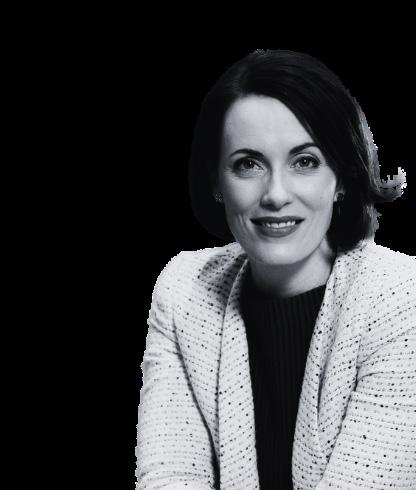
The goals emphasize the interconnected environmental, social and economic aspects of sustainable development by putting sustainability at their center. The following chart illustrates how most of the SDGs are interrelated:
In 2019, to transform the region into a “modern, resourceefficient and competitive economy,” the European Union announced its EU Green Deal Commitments. One of its targets is to reach net zero - or no net emissions of greenhouse gasses - by 2050. To support its initiative, the EU budgeted for investments of €1 trillion by 2030. Major private sector investments are also foreseen for this decade. In 2021, the EU began rolling out its new Environmental, Social and Governance (ESG) regulation, which is used to screen investments based on corporate policies and to encourage companies to act responsibly. This will have a significant impact on businesses as well as on debt financing activity through the capital markets.
The SDGs provide a common language as well as a compass for the challenges of the 21st century. The commitment of politicians, civil society and the business community is required. As the general understanding of climate change grows, more local and global companies as well as communities and cities embrace SDGs where they can contribute and impact directly. Many understand the necessity to repair what has been done, as well as the formidable potential SDGs represent for the environment as well as the many stakeholders in our society and economy.
With figures such as these from the 2022 World Economic Forum Risk Report, there is urgency in us all moving ahead on SDGs:
Why are we in such a catastrophic situation? Mainly because of our unsustainable lifestyle, where the over-exploitation of natural resources in parallel with economic and demographic growth, market prices not reflecting hidden environmental costs, as well as accelerated resource depletion, waste generation and environmental pollution, due to shortened product lifecycles and changing lifestyles.
Reporting on these new rules represent a new regulatory paradigm for businesses, with the EU Taxonomy as its backbone. As a consequence, CFOs are generally in charge of sustainability, though many companies have ramped up their finance organizations and created a dedicated role, the Chief Sustainability Officer or CSO. In parallel to the reporting aspect and the achievements of the EU targets, many companies included 3 to 8 SDGs in their specific ESG goals. Why so? The EU ESG rules are more general to allow companies to mold the regulation for their specific usage when the SDGs are specific about the targets to be achieved. As seen in the figure above, it makes sense to correlate these United Nations and European Union goals.
Achieving our climate goals requires a transformation of our energy systems and how we produce and consume goods. In the context of this transformation, there are two definitions to keep in mind:
• The Three Ps - People, Planet, and Profit, also known as the Triple Bottom Line (TBL)
1. Society, Environment, and Finance. The TBL or 3Ps framework measures profits by taking into account the return on investment, the shareholder value and social and environmental dimensions.
2. Social measures such as quality of life, unemployment rate, gender equality, income, relative poverty, higher education, average commute time, crime and life expectancy.
3. Environmental measures such as air and water quality, energy consumption, natural resources, solid and toxic waste, land use and land cover.
• The Genuine Progress Indicator (GPI) aims to measure whether the environmental impact and the social cost of economic production and consumption in a country are negatively or positively affecting the overall health and well-being of the society.
Source: Prof. Dr. Khaled Soufani, Cambridge Judge Business School
» Use cases
Policy and regulation have shown the transformation which can happen at a system level. When embracing the rules of the game and setting strategic directions, the results can be astonishing:
• Stimulating and de-risking innovation through innovation co-funding, fiscal incentives and business support. E.g. German car manufacturers, which decreased average CO2 emissions to 122 g/km since 1995, saw a total reduction of more than 42%
Source: BMW Group “BMW Group reduces CO2 emissions in Europe again“
• Leveling the playing field via carbon taxes, plastic bans, and eco-design regulations. E.g. LG aims to reduce its greenhouse gas emission by 40% and increase in new green businesses:
Source: LG Electronics “2012 Environmental Report“
• Public procurement co-investments in infrastructure, such as connectivity, energy grid, charging networks, or education. E.g. the German state of North RhineWestphalia with its NRW Energy4Climate
Source: NRW.Energy4Climate
Overall, companies are multiplying investments and efforts to be compliant with the targets, if not surpass them. In doing so, the interrelation between the environment, society, and governance manifests in different ways. In general, common sustainable objectives can be seen in the ESG reports: (1) saving energy, (2) developing green products, and (3) retaining and motivating employees.
Here are only a few examples:
• Complying with regulations: Many corporations are taking proactive approaches to sustainability, such as Merck Group and Siemens. Governmental pressure and regulation constitute an important driver for change.
• Meeting public expectations: Coca-Cola, L’Oréal, Mars, Nestlé, Unilever have all announced working towards using 100% reusable and recyclable or compostable packaging by 2025.
• Avoiding bad press: Coca-Cola, Procter & Gamble, Unilever are developing marketing strategies to publish their commitment to society and the environment.
• Boosting their business by saving energy: One example is BASF, which adopted a “Verbund” system that adds value through more efficient use of resources. BASF has saved 19.2 million megawatts, which corresponds to 3.9 million metric tons of CO2 emission.
• Recruiting and motivating employees: Millennials in particular prefer to be associated with companies known for low pollution and high ethical standards.
• Rewarding good behavior: ING Bank is choosing companies that integrate sustainability in their business strategies to achieve lower costs of capital and to create more value. A study conducted by the bank demonstrated that these companies produce 33% higher returns than their less resource-efficient competitors, they display high levels of innovation and entrepreneurship and are aware of the economic imperatives produced by resource constraints.
Let’s recall the classic example of the commercial carpet and tile company Interface, whose late founder and CEO Ray Anderson had little environmental awareness until August 1994. Since then, here are some of their significant achievements, including those overseen by newlyappointed CEO, Laurel Hurd.
In a recent study, PwC highlights that reporting on the management of climate risks and opportunities is still in the starting blocks. For example, only 6 out of 10 companies in Norway have a climate strategy
Let’s be clear: taxonomy without action isn’t enough. That is greenwashing. It’s also not just about being compliant with reporting. It’s about using vision to create a winning business strategy and turning problems into business opportunities. It’s also about convincing shareholders and stakeholders to make hard choices and invest in new areas. In the end, as Dr. Khaled Soufani pointed out: “What is the role of the CEO, Board, Management Team? It is to keep the company relevant, even when the world shifts around them.”
When talking to companies that produce a sustainability/ ESG report, they basically all agree that the next step is the circular economy. Why is this so relevant?
The good news, according to PwC, is that companies are increasingly aware of climate change risks and opportunities, and how it reflects on their business. However, only 10 companies out of 100 are reducing their emissions in line with the Paris Agreement.
The circular economy is a relatively nascent approach to sustainability. The Ellen MacArthur Foundation describes it this way: “In our current economy, we take materials from the Earth, make products from them, and eventually throw them away as waste – the process is linear.”
In a circular economy, by contrast, we stop waste from being produced in the first place. The circular economy is based on three principles, driven by design:
• Eliminate waste and pollution
• Circulate products and materials (at their highest value)
• Regenerate nature
This is underpinned by a transition to renewable energy and materials. “A circular economy decouples economic activity from the consumption of finite resources. It is a resilient system that is good for business, people and the environment.”
The PwC study underscores that only 40% of companies have linked their climate goals to a specific roadmap that sets out clear milestones, intermediate targets and measures.
But let’s begin with understanding the errant nature of a linear process. When looking at business models, this is valid for linear business models as well as for platform models and ecosystems. What makes the difference? Let’s have a look at the linear economy, aka from the cradle to grave, which is optimized to deplete resources and increase landfills:
Or expressed differently:
This process is unidirectional and uses natural resources for mass production. Products are disposed of, often after a single use. Our traditional understanding of business models generates too much production and consumption, with the consequence that our consumption of natural resources is 50% faster than their replacement. By 2030, the equivalent of two planets of natural resources will be required. By 2050 the number increases to the equivalent of three planets.
The principles of circularity, aka from cradle to cradle, make businesses more sustainable, which aims at preserving resources while reducing landfills.
The benefits of circularity are manifold:
• Reducing dependence on new material resources
• Reducing waste
• Reducing costs
• Contribution to the 3Ps - People, Planet, Profit
The Ellen MacArthur Foundation created a framework, represented by their butterfly diagram:
As early as 2014, experts found that switching to a circular economy would lead to the elimination of 100 million tons of waste worldwide in barely five years. Meanwhile, the consumption of new materials would be reduced by 32% within 15 years, and by 53% by 2050. Source: www. trendsformative.com “The circular Economy a Choice for Society and Business
Circularity relates to:
• Designing out waste and striving toward zero waste
• Building resilience by reusing available resources
• Using energy, mainly from renewable sources
• Thinking in systems and understanding their interdependencies
• Thinking in cascades to identify the most suitable approach
» Initiatives driven by the circular economy
Digital technologies, such as Internet of Things, Machine Learning, and Blockchain, are important enablers of circularity, as they can trace and measure the data needed, for example from Scope 3 to all other elements of the butterfly framework. The evolution of these technologies can be seen as something positive: companies produce products and services in more efficient and effective ways, and generate the data and information to foster continuous learning and development.
Additional enablers of a circular economy model to consider are: Impact Investments, Management Commitment, Infrastructure and Government Policy.
The circularity concept is adding the “Reuse - RepurposeRemanufacture - Recycle” to the existing business model, which follows mainly the principles “Take - Make - Dispose”. It attempts to bring back into the system everything relating to production, distribution, consumption and to extract as much value as possible the resources used in the most effective way.
Circularity requires organizations along the value chain to explore adopting disruptive technologies, aimed at increasing the asset’s life, and resorting to reusing, repairing, and remanufacturing. This approach requires the design and implementation of business and financial models that are “based on using as little resources as possible for as long as possible, and extract as much value as possible”, says Prof. Dr. Khaled Soufani, Circular Economy at Cambridge Judge Business School
The examples below show that there are no limits in incorporating the framework of the circular economy into a business model. It only needs to be part of the business vision and strategy and that enablers, stakeholders, and business models are being led by circularity.

Develops and manufactures a tailored Internet of Things (IoT) Smart Agriculture management platform to enable services that allow growers to observe, measure, and respond to the invironmental conditions, diseases and pests that affect their agricultural production. This makes crop and farm management more effective and assets more productive even when used at small scale.
Enables businesses to increase understanding of their material world. Provenance uses blockchain as a platform to help businesses and consumers keet track of materials and asscociated data through asset use cycles. The model has the potential to lay the foundations for an open, secure register for all material items.
This platform facilitates the sale or solar-powered devices to end users in the developing world, laying the foundation for the creation of prosperous grid-free societies without the vast investments and resources associated with tradictional power infrastructure.
Is pioneering the Smart Port concept thourgh the implementation of Europe’s first ‘smartROAD’. The smartROAD Proof of Concept aims to improve infrastructure condition, resource management, traffic flow and environmental management using an IoT approach with real.time data and analytics.
To support product managers to optimise the reuse of products, components and materials. The tool integrates and analyses the relevant data sets around the product specs, journey and market data, to enable a more informed decision making process. This resulsts in increased resource productivity as well as financial and environmental benefits.

“Sustainability gives us a chance to build up new growth opportunities, not just according to some standards and regulations, but also see this as an opportunity to build a new business.“
A great way to introduce the immense and various business opportunities is in terms of growth. The EU’s ESG regulations (Environmental, Social and Governance), the UN’s SDGs (Sustainable Development Goals) and CE (Circular Economy) all offer a variety of possibilities in terms of value propositions
Investors refer to ESG as the ESG Advantage because of improved financial performance and investment returns. The S&P Global Rating report underlines the growth opportunity.
Consulting firms are rapidly ramping up. By 2025, every consulting project will cover ESG elements Sustainability is definitely a growth market, which requires heavy investments too. Investments that seem to pay off.
Fig 56 - Source: World Economic Forum and Ellen MacArthur Foundation “Intelligent Assets - Unlocking the circular economy potential” | 2016British Sugar invested around £250 million in efficiency over the last few years in support of their circular economy approach. This led to energy efficiency through leading technology and continuous process optimization on the use of the raw material. Results: next to their core product (sugar), twelve additional revenue streams were generated from waste.
Ørsted was once one of the most coal-intensive energy companies in Europe. Today, it is a leading sustainable energy company in the transition to green energy. Going through this transformation and rewriting the DNA of their company wasn’t easy, but black energy wasn’t a sustainable option. Results: Offshore wind in 2019, from 15% to 85% renewables in 10 years (from a 30-year target), the largest offshore wind developer with a commitment to sustainable turbines and blades. By 2027, they plan to invest an additional US$57 billion to quadruple renewable energy.
Omocon, the Swedish insurtech startup builds its insurance services around keeping products in use. There is a growing need for on-demand micro-insurance for peer-to-peer sharing, rental business models and transport for rented and refurbished products. This impacts how traditional warranties and guarantees have to be rethought by the insurance industry. Results: Omocon got US$3.7 million to insure the circular economy
Sustainability is the right choice for so many reasons. We are just at the beginning of a powerful, impactful and transformative journey into sustainability based on the 3 Ps - People, Planet, Profit. The circular economy presents even more options, also because it is built on partnerships and ecosystems to our mutual benefit. ESG and SDGs
provide guidelines that help us to set off in the right direction with clear targets.
The entirety of a company needs to be part of this journey and help to answer the three key questions:
• What problems/needs are we addressing for whom (Creating Value)
• How do we address that problem/need (Delivering Value)
• How do we retain some value for ourselves and our stakeholders (Capturing Value)
The objective of sustainability is to eliminate wasted resources, capacities, lifecycles, and embedded values. A big part of the solution is the circular economy, supported by appropriate business models, using the required technologies, and utilizing the right capabilities.
Pauline Pezerat Co-founder & Managing Partner Flying Rhino Studio“We launched Flying Rhino Studio because we are convinced that the economy of ecosystems makes it possible to address the systemic issues of our society. Companies that will lead EU economy to a sustainable economic model will be those that orchestrate the environmental and social transitions of an ecosystem. CSR is our north star and European SMEs represent a tremendous potential on which we must rely to accelerate transitions: together we build, scale and monetize platform ventures with impact (corporate venturing).“

With the sustainable movement growing around the world, digital sustainability is also now gaining attention. Digital sustainability is the practice of using digital technologies to minimize the associated negative environmental impact. Businesses and consumers have started to see the importance of green technology. Implementing digital sustainability into business operations shows that companies are socially conscious and are making efforts to limit their carbon footprint.
Beyond what is required for basic life, digitalization is beginning to play an important part in defining what we desire. Many businesses encourage customers to buy more than they truly want in order to increase sales and profits at the expense of the environment. Many of the current policies, practices, innovation tactics and institutions are driven by a preference for fast economic development while ignoring environmental, social and quality of life concerns. There are additional issues around privacy,
cyber security, and cyberbullying. In contrast, digital sustainability opens up new possibilities for a thriving society founded on collaboration and sharing.
We have an imperative to reverse these negative tendencies and harness the power of digital transformation as a critical instrument in building globally sustainable economic and social norms. The UN Environment Programme’s CODES Action Plan explores the intersectionality between digital technology and sustainability, proposing three main shifts:
1. Enable Alignment - provide the environment for aligning the vision, find a common purpose by developing standards.
2. Reduce Negative Impacts - a long-term commitment to digitization that reduces the negative environmental and social consequences of digital technology.
3. Accelerate Innovation - increase investments in digitalization for sustainability.
Here are a few examples of top technologies related to sustainability:
Research by PwC UK, commissioned by Microsoft, models the economic impact of AI’s application to manage the environment, across four sectors – agriculture, water, energy and transport. It estimates that using AI for environmental applications could contribute up to US$5.2 trillion to the global economy in 2030, a 4.4% increase relative to business as usual.
As a practical example we have KoBold, an AI-powered discovery system that combines world-class geological experience, extensive data collection, and powerful AI technology with the objective of finding minerals vital for the production of EV batteries. More than 99% of exploration projects fail to become mines, and the industry now spends three times more to make 60% fewer discoveries compared to 30 years ago. Finding new deposits requires the ability to peer into the Earth’s subsurface in innovative ways. This system accelerates the discovery and responsible development of previously unknown battery mineral deposits buried deep below the earth’s surface.
IoT is applicable to all industries and is one of the fastestgrowing IT sectors, hitting US$300.3 billion in 2021, with the expectation that it will reach US$650.5 billion by 2026. Generally, all IoT devices have a common goal: data collection. This means they constantly obtain information and send it to data centers for analysis. IoT sustainable efficiency is based on monitoring, measuring, cataloging and analyzing.
Particularly in comparison to other tech products, IoT can deliver greener results because it uses fewer hardware components and generates less e-waste. For this reason, IoT devices have less memory capacity, which means that IoT software should be designed specifically to operate on limited resources while remaining as efficient as possible.
BASF Coatings, the IoT solution for Intralogistics, is one example. Coordinating the process of moving 450 trolleys (carrying raw materials and products) at the site in a targeted manner was a challenge. The solution has helped BASF optimize in-house transportation, reduced empty runs (with associated cost and fuel) and make the process more efficient.
Blockchain and cryptocurrencies have many exciting application possibilities, but they also have a significant negative environmental impact, mainly related to energy consumption. There has been no moral argument over the energy effect of domestic fridges or tumble dryers since they serve important purposes in our lives. The difference is that crypto has not yet become a socially recognized instrument that serves an important purpose.
A pilot project started at Iberdrola Group uses blockchain to ensure in real time that the energy delivered and consumed is 100% renewable. According to them, “using this technology, we were able to connect facilities where power is generated to precise sites of consumption, allowing us to trace the source of the energy”. We have plenty of meaningful action by the crypto industry. For example, KlimaDAO, a DAO built on the Polygon blockchain (highly energy efficient) and a digital currency backed by real carbon assets; or The Regen Network, which incentivizes ecosystem regeneration, unlocking Web3 regenerative finance.
Catherine Schoendorff CEO at DIVVA
The Smart Digital Consultancy
“IoT = Interconnectivity of devices via the internet, enabling them to collect and transfer data without human
The EU enforces some of the world’s strictest environmental standards, which have been created over decades. Environment policy helps the EU economy become even more environmentally friendly, preserves Europe’s natural resources, and protects the health and well-being of EU citizens.
Jens Deppe Managing Partner sleeperoo
A variety of ESG-related regulatory initiatives have been and will be introduced that will impact how corporations operate inside the European Union. Keeping up with these might be difficult for businesses that must adhere to stringent rules. Let’s review the current and upcoming ESG-related legislation in the EU, according to Euronext:
Corporate Sustainability Reporting Directive (CSRD): In June 2022 the European Parliament and Council reached agreement on this directive. The new rules will ensure that investors and other stakeholders have access to the information they need to assess investment risks arising from climate change and other sustainability issues.
EU Green Bonds Regulation (EUGBR): A voluntary standard which aspires to set a ‘gold standard’ through the standardization of market practices.
Corporate Sustainability Due Diligence Directive (CSDDD): Ensures that businesses address the adverse impacts of their actions, including in their value chains inside and outside Europe.
Source: https://www.euronext.com/en/news/esg-laws-regulation
“Regulatory changes that are going on are more related either to environmental topics and sustainable topics.“
A project by Futurity Systems, in partnership with Vantagedigital for Web3 development and AR experience designed by Explorins
Imagine a world where plants have the power to generate, mint and sell their own NFT images. The Plantiverse is the world’s first NFTrees – each designed by plants, for the benefit of Plants – seeded on Solana blockchain Plantiverse was created as a way to generate NFT use cases for sustainable development.
The system works as follows:
• The moment you buy a NFTree, by utilizing a visual representation of the plant’s health condition, you are assisting plants in real life.
• Organic plants transmit their status to a computer via sensors, and their findings alter the form, colors, and other features of the image you see.
• The proceeds will be used to safeguard real-world forests, wetlands, and other natural habitats.
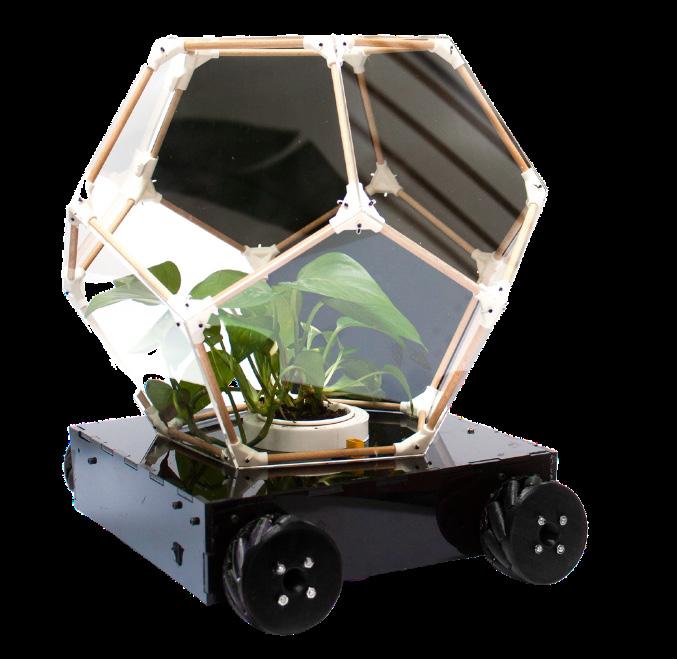
With sensors that measure the vital signs of Herbie, and can help maintain its needs.
These NFTrees aren’t only in the metaverse: people can experience them via SOFT, The Store of Future Things, a blend of physical and digital (phygital) technologies, arts, and sensations. The first SOFT is located in the heart of Barcelona. The first 500 NFTree images are beautiful depictions created by plant artists; 3D versions are already in the making and will be minted in the second round of NFTrees. Visitors at SOFT can already walk among both AR and VR versions of the NFTrees
Cecilia Mosze Tham Co-Founder
“In the pipeline, we will introduce these natural artists’ work from forests in the Amazon, Costa Rica, and Mexico (more NFTrees), as well as the Oceans (NFSeas) and Bees (NFBees). Sensationlinked sensors provide a way for the plant to communicate with us humans about their health status, and give them a way for them to raise money for themselves.”
Converts the sensors data into visualization of a digital twin of Herbie, which its called NFTrees, that people can purchase. The funds are in crypto, owned and managed by Herbie.
AR versions of the digital twins so that people can experience a more realistic rendering of these NFTrees.


Fig 1 - Source: © Copyright 2023 ECODYNAMICS GmbH | Hamidreza Hosseini | Dr. H. Schmidt | September 2022
Fig 2 (p. 10) - Source: Corporate Europe Observatory & Lobbycontrol based on EU Transparency Register | August 2021 - https:// corporateeurope.org/sites/default/files/2021-08/The%20lobby%20network%20-%20Big%20Tech%27s%20web%20of%20 influence%20in%20the%20EU.pdf
Fig 3 (p. 11) - Source: TheNTWK based on Dealroom Database | November 2022
Fig 4 (p. 11) - Source: European Startups Report “The definitive data behind the past, present and future of European Tech” | December 2021 - https://sifted.eu/intelligence/reports/european-startups
Fig 5 (p. 13) - Source: cointelegraph.com “What is Lens Protocol, and how does it work?” | October 2022 - https://cointelegraph.com/ news/what-is-lens-protocol-and-how-does-it-work
Fig 6 (p. 13) - Source: Adapted from J. Owang “Web3 Use Cases: Five Capabilities Enabling People” | March 2022 - https://webstrategist.com/blog/2022/03/18/web3-use-cases-five-capabilities-enabling-people/
Fig 7 (p. 14) - Source: “7 Highlights From ‘A Deep Dive Into Decentralization’ Webinar Featuring Braintrust” | September 2021 - https://medium.com/quantum-economics/7-highlights-from-a-deep-dive-in-to-decentralization-webinar-featuring-braintrust-held9-25-21-802eef35149f
Fig 8 (p. 14) - Source: “Token Economy” Book by Shermin Voshmgir | 2019
Fig 9 (p. 15) - Source: geeksforgeeks.org “Smart Contracts in Blockchain” | September 2022 - https://www.geeksforgeeks.org/smartcontracts-in-blockchain/
Fig 10 (p. 15) - Source: coinflip.tech “Cryptocurrency Explained: AAVE” - https://coinflip.tech/learn/cryptocurrency-explained-aave
Fig 11 (p. 16) - Source: coinledger.io “The Comprehensive Guide to DeFi Taxes” | 2022 - https://coinledger.io/blog/defi-crypto-taxguide
Fig 12 (p. 19) - Source: StackOverflow “New data: Do developers think Web3 will build a better internet?” | April 2022 - https:// stackoverflow.blog/2022/04/20/new-data-developers-web3/
Fig 13 (p. 21) - Source: Venture Beat “Metaverse 101: Defining the key components” | February 2022 - https://venturebeat.com/ business/metaverse-101-defining-the-key-components/
Fig 14 (p. 22) - Source: Sean Graglia via Linkedin “Three Ways to Look at the Metaverse” | October 2022 - https://www.linkedin.com/ pulse/three-ways-look-metaverse-sean-graglia/
Fig 15 (p. 23) - Source: Deloitte “Metaverse report - Future is here“ | March 2022 - https://www2.deloitte.com/cn/en/pages/technologymedia-and-telecommunications/articles/metaverse-whitepaper.html
Fig 16 (p. 24) - Source: Venture Beat Report “33% of devs say data privacy is a big obstacle for the metaverse” | April 2022 - https:// venturebeat.com/enterprise/report-33-of-devs-say-data-privacy-is-a-big-obstacle-for-the-metaverse/
Fig 17 (p. 24) - Source: TheNTWK based on Ethical Metaverse Principles | November 2022 - https://responsiblemetaverse.org/ resources/
Fig 18 (p. 25) - Source: “Human-centric platforms for personalized value creation in the metaverse” | November 2022 - https://www. sciencedirect.com/science/article/abs/pii/S0278612522001959
Fig 19 - Source: © Copyright 2023 ECODYNAMICS GmbH | Hamidreza Hosseini & Peter C. Evans, PhD | May 2022
Fig 20 (p. 28) - Source: Twitter @lililashka | January 2022 - https://twitter.com/lililashka/status/1481639448425074694
Fig 21 (p. 29) - Source: opensea.io, Richard Chen, Dune Analytics | October 2022 - https://www.reuters.com/technology/nft-salesplunge-q3-down-by-60-q2-2022-10-03/
Fig 22 (p. 30) - Source: TheNTWK NFT Marketplace “Using Dynamic NFTs for engaging communities” | June 2022 - https://www.thentwk.com/post/thentwk-nft-game-rules-1
Fig 23 (p. 31) - Source: nupurjalan.com “Taxation of virtual assets” | October 2022 - https://nupurjalan.com/wp-content/ uploads/2022/10/Taxation-of-Virtual-Digital-Assets-.pdf
Fig 24 (p. 31) - Source: PwC UK “Non-Fungible Tokens: Significant and Emerging VAT issues” | July 2022 - https://www.pwc.co.uk/ services/tax/indirect-taxes/non-fungible-tokens-significant-and-emerging-vat-issues.html
Fig 25 (p. 33) - Source: McKinsey & Company “How COVID-19 has pushed companies over the technology tipping point—and transformed business forever” | October 2020 - https://www.mckinsey.com/capabilities/strategy-and-corporate-finance/our-insights/ how-covid-19-has-pushed-companies-over-the-technology-tipping-point-and-transformed-business-forever
Fig 26 (p. 34) - Source: Medium “The present-day non-linear customer journey map (eg: Ikea)” | October 2019 - https://www. mantralabsglobal.com/blog/new-product-is-the-customer-journey/
Fig 27 (p. 35) - Source: World Experience Organization “The Progression of Economic Value” | November 2020 - https://worldxo.org/ progressioneconomicvalue/
Fig 28 (p. 36) - Source: Peter C. Evans, Platform Strategy Institute | 2020
Fig 29 (p. 37) - Source: BRAND N3XT “From Short-Termism to Longevity: Why marketers should use web3 for brand building“ | October 2022 - https://brandn3xt.substack.com/p/from-short-termism-to-longevity-why
Fig 30 (p. 37) - Source: Balthazar, DappRadar | December 2022 - https://www.bloomberg.com/news/articles/2022-12-07/nft-salesdrop-to-16-month-low-in-ftx-collapse-aftermath-chart
Fig 31 (p. 38) - Source: New Trend Report “Into the Metaverse” (Wunderman Thompson); Value Creation in the Metaverse (McKinsey) | June 2022 - https://www.mckinsey.com/capabilities/growth-marketing-and-sales/our-insights/value-creation-in-the-metaverse
Fig 32 (p. 38) - Source: World Economic Forum “How enthusiastic is your country about the rise of the metaverse?“ | May 2022https://www.weforum.org/agenda/2022/05/countries-attitudes-metaverse-augmented-virtual-reality-davos22/
Fig 33 (p. 44) - Source: White Label Loyalty “A customer loyalty guide to web3: the future of brand engagement” | July 2022 - https:// whitelabel-loyalty.com/blog/marketing-brand-activation/a-customer-loyalty-guide-to-web-3-the-future-of-brand-engagement
Fig 34 (p. 47) - Source: TheNTWK Survey | October 2022
Fig 35 (p. 48) - Source: platformthinkinglabs.com “Ecosystem business models: A teardown” - https://platformthinkinglabs.com/ materials/ecosystem-business-models-a-teardown/
Fig 36 (p. 49) - Source: TheNTWK Survey | October 2022
Fig 37 (p. 50) - Source: European Digital Forum, IESE Business School | November 2022
Fig 38 (p. 51) - Source: European Digital Forum, IESE Business School | November 2022
Fig 39 (p. 51) - Source: Startup Talky “6 Reasons Why Nokia failed After Enjoying Unrivaled Dominance” | July 2022 - https:// startuptalky.com/reasons-why-nokia-failed/
Fig 40 (p. 52) - Source: Bancolombia Group | 2019 - https://www.bancolombia.com/wps/wcm/connect/cc426a68-9878-4e7d-817efd4d15629354/Luis+Miguel+Zapata.pdf?MOD=AJPERES&CVID=mPg9Emj
Fig 41 (p. 54) - Source: Periodic Reporting for period 3 - Smart4Health (Citizen-centred EU-EHR exchange for personalised health) | December 2021 - https://cordis.europa.eu/project/id/826117/reporting
Fig 42 (p. 55) - Source: PingAn “Healthcare Ecosystem” | 2021 - https://group.pingan.com/about_us/our_businesses/health-careecosystem.html
Fig 43 (p. 57) - Source: worldbank.org “WHAT A WASTE 2.0: A Global Snapshot of Solid Waste Management to 2050” - https:// datatopics.worldbank.org/what-a-waste/trends_in_solid_waste_management.html
Fig 44 (p. 57) - Source: globalcompact.de - https://www.globalcompact.de/en/our-work/sustainable-development-goals
Fig 45 (p. 57) - Source: World Bank, 2018 | Statista, 2021 (Based on Data by the Global Footprint Network) - https://openknowledge. worldbank.org/handle/10986/30317 | https://www.statista.com/chart/10569/number-of-earths-needed-if-the-worlds-populationlived-like-following-countries/ | https://www.overshootday.org/how-many-earths-or-countries-do-we-need/
Fig 46 (p. 58) - Source: worldbank.org “WHAT A WASTE 2.0: A Global Snapshot of Solid Waste Management to 2050” - https:// datatopics.worldbank.org/what-a-waste/trends_in_solid_waste_management.html
Fig 47 (p. 58) - Source: Anevis Solution “ESG – Reporting Part I Basics” | 2020 - https://www.anevis-solutions.com/2020/esg-reportingpart-i-basics/
Fig 48 (p. 58) - Source: World Economic Forum ”The Global Risks Report 2022 17th Edition” | 2022 - https://www3.weforum.org/docs/ WEF_The_Global_Risks_Report_2022.pdf
Fig 49 (p. 59) - Source: www.interface.com “Sustainability Overview” | 2023 - https://www.interface.com/US/en-US/sustainability/ sustainability-overview.html
Fig 50 (p. 60) - Source: PwC at the Oslo Business Forum | December 2022
Fig 51 (p. 60) - Source: PwC at the Oslo Business Forum | December 2022
Fig 52 (p. 60) - Source: PwC Germany “PwC study on the climate reporting of listed companies” | December 2020 - https://www.pwc. de/en/sustainability/pwc-study-on-the-climate-reporting-of-listed-companies.html
Fig 53 (p. 61) - Source: Adapted from Prof. Dr. Khaled Soufani, Circular Economy at Cambridge Judge Business School | 2022
Fig 54 (p. 61) - Source: Ellen MacArthur Foundation “Circular economy systems diagram” | February 2019 - https:// ellenmacarthurfoundation.org/circular-economy-diagram
Fig 55 (p. 62) - Source: Circular Economy, Cambridge Judge Business School | 2022
Fig 56 (p. 63) - Source: World Economic Forum and Ellen MacArthur Foundation. “Intelligent Assets - Unlocking the circular economy potential” | 2016 - https://ellenmacarthurfoundation.org/intelligent-assets-unlocking-the-circular-economy-potential
Fig 57 (p. 63) - Source: McKinsey & Company “The ESG premium: New perspectives on value and performance” | 2020 - https://www. mckinsey.com/capabilities/sustainability/our-insights/the-esg-premium-new-perspectives-on-value-and-performance
Fig 58 (p. 65) - Source: The U.N. Environment Programme’s CODES Action Plan Report “Three Shifts and 18 Strategic Priorities to Achieve a Sustainable Planet in the Digital Age” | June 2022 - https://www.unep.org/resources/report/action-plan-sustainableplanet-digital-age
Fig 59 (p. 66) - Source: Report by ABB “The state of the Industrial IoT“ | https://stories.ability.abb.com/better-decisions/the-industrialiot/
Fig 60 (p. 67) - Source: Compliance Solutions Strategies CSS “ESG Regulations Take Hold in Europe With Other Regions Set to Follow” | August 2022 - https://cssregtech.com/2022/08/esg-regulations-take-hold-in-europe-with-other-regions-set-to-follow
This 2023 EU Digital Trends Report was co-created by an incredible network of passionate people. While the Report co-creation process was opened to TheNTWK Community, the following individuals deserve specific acknowledgment for their contributions, engagement and commitment:
Alun Evans - CEO of Freeverse
Anna Noakes Schulze - Head of Community Experience at TheNTWK
Bety Soca - Full Stack Developer & Product Owner at TheNTWK
Catherine Schoendorff - CEO at DIVVA The Smart Digital Consultancy
Cecilia Mozse Tham - Co-founder of Futurity Systems
Daniel Trabucchi - Senior Assistant Professor Politecnico di Milano
Dyan Finkhousen - Founder & CEO Shoshin Works
Ekaterina Maikova - Business Development Manager at TheNTWK
Erich Joachimsthaler - Founder & CEO of Vivaldi Group
Geoffrey Parker - Professor at Dartmouth College, Co-author of the “Platform Revolution” Book
Hamidreza Hosseini - CEO of Ecodynamics
Jens Deppe - Managing Partner at sleeperoo GmbH
Jeroen Ermers - Product Owner Platform, Ecosystem & Strategy Services at Cegeka
Joe Pine - Co-founder Strategic Horizons
Juan Campderà - CEO of Aktiva Brand Experience Design
Julian Kawohl - Professor of Strategic Management and Founder of Ecosystemizer
Liza Engel-Lambert - Chief Sustainability Officer, Managing Partner at Deloitte Switzerland
Luis Miguel Zapata - Vice President Bancolombia Ecosystem
Mª Julia Prats - Professor and Executive Board Member at IESE Business School
Marina Planas - Co-founder & CEO of TheNTWK
Mark Boyd - Director of Platformable
Marta Agrech - Digital Transformation & Innovation Manager at Sopra Steria Next
Martha Boeckenfeld - Dean & Partner, Thought Leader & Advisor at Metaverse Academy
Matthias Walter - CEO of fastbreak.one
Milja Van ’t Noordende - Strategist at North&
Miriam Van Straelen - Partner at Roland Berger
Natalia Olson Urtecho - Director of Government Partnerships Plug and Play Tech Center
Nupur Jalan - Chartered Accountant, Adv. LL.M. (International Tax Law) Tax Consultant
Oliver Birk - Platform Business at BASF Coatings
Orlando Vergara - Former Business Franchise Head Neuroscience Spain at Novartis
Paul Hobcraft - Transformations, Innovation and New Business Designer
Pauline Pezerat - Co-founder & Managing Partner at Flying Rhino Studio
Peter C. Evans - Chief Strategy Officer at McFadyen Digital
Sameer Singh - Network Effects Investor, Atomico Angel, Creator of Breadcrumb.vc & Applied Network Effects
Sangeet Paul Choudary - Founder of Platformation Labs, Co-author of the “Platform Revolution” Book
Santiago Sanchez - CEO TheEtaliers
Sergi Sagàs - Chief Innovation Officer at Hyperreal
Simon Torrance - Founder Embedded Finance & Super App Strategies
Simone Cicero - CEO of Boundaryless
This report, a compilation of seven deep dives over five months, was compiled, edited, and designed by Bety Soca, with research by Anna Noakes Schulze, Bety Soca, Catherine Schoendorff, and revision by Marta Agrech, Marina Planas and Milja Van ‘T Noordende.
Get your tickets here!

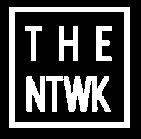

If you are ready to transition and go beyond traditional business, TheNTWK is just the place for you. All our members help each other out in this process. How? We are a community of passionate members that share knowledge and expertise in the field of digital business models and innovation.

- An initial assessment to identify the status quo of your idea, project, or business, doesn’t matter at the phase you are in. The Assessment will help you to identify the weak and strong aspects of your platform.
- The best-curated material of knowledge and
expertise, regarding the moment of business transformation where you are. Access to exclusive content, events like TheNTWKTalks, every Thursday, workshops, courses, and more.
- TheNTWKTeam and NTWKers, will help and guide you through all the transformation process, within your business and even your personal transformation.
Build personal relationships with thought leaders & professional peers that understand your needs!
REQUEST ACCESS or CONTACT US for more information.
